COMPREHENSIVE AND IN-DEPTH COURSE ON WING CHOON KUNGFU
Penang 29 April to 5 May 2010
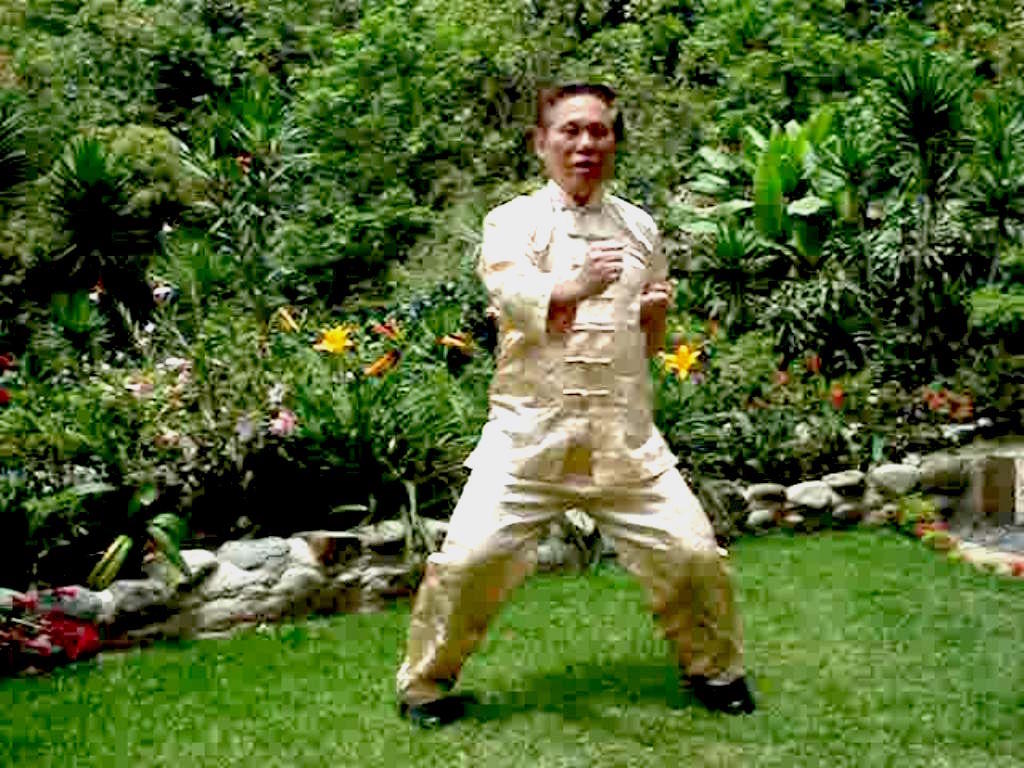
Grandmaster Wong performing Siu Lin Tou
This course represents the legacy of Sifu Choy Hoong Choy, who was Grandmaster Wong's fourth kungfu teacher. Amongst the many special skills taught in the course are developing internal force using Siu Lin Tou, and being able to deflect an opponent's attacks without looking at them.
The instructional material is classified into the following sections:
- Preliminaries
- Stances and Forms
- Internal Force with Siu Lin Tou
- Chi Sau or Sticking Hand
- Cham Kiew or Searching for Bridge
- Wing Choon Combat Sequence
- Developing Sensing Skills
- Hand Techniques in Chi Sau
- Phew Chee and Free Sparring
- Kicking Techniques in Chi Sau
- Felling and Chin-Na Techniques
- Sophisticated Applications from Innocent-Looking Patterns
- Felling, Knee Jabs and Gripping
- Minimum Force and Blind-Fold Sparring
- From Technique-Sparring to Sequence-Sparring
- Delving into Wing Choon Secrets
- Against Boxing, Kick-Boxing and Taekwondo
- Against Muay Thai and Wrestling
- Grand Finale and Post-Script
A shorter version of the same review can be accessed here
Preliminaries
Developing Internal Force using Siu Lin Tou
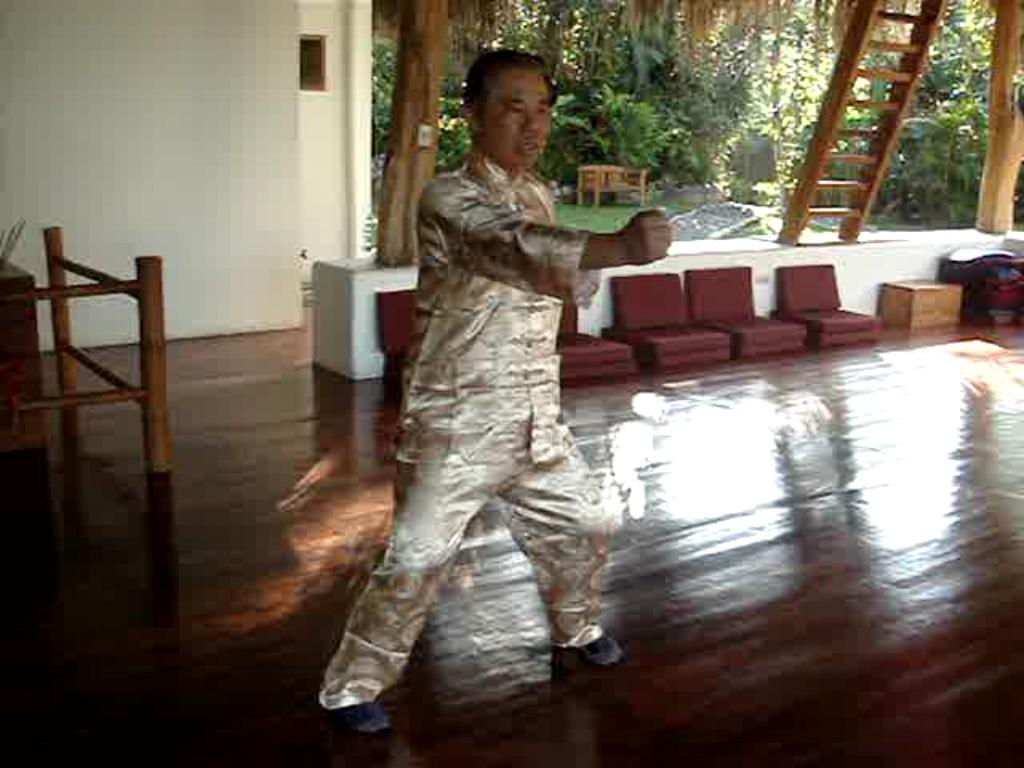
Wing Choon masters in the past like Yim Wing Choon and Leong Chan were gentle and elegant but well known for their internal force. They did not punch sandbags, and did not lift weights. How did they become so powerful?
Click here to enter.
Learning the Forms of Siu Lin Tou
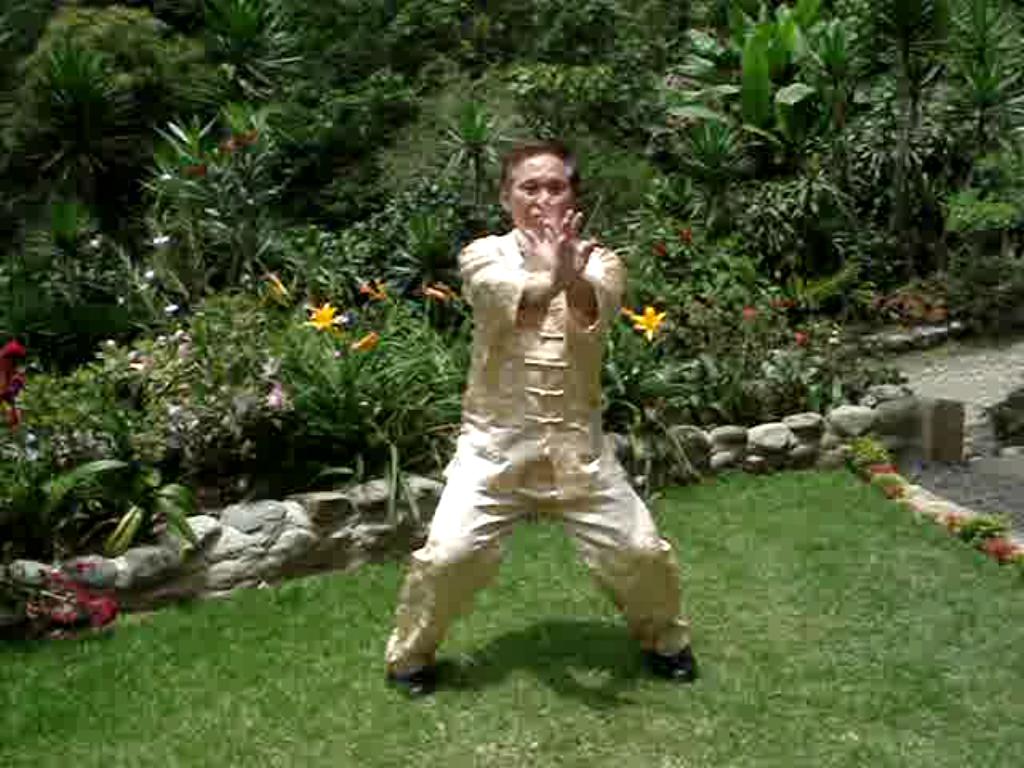
In Choe Family Wing Choon, the fundamental set is called "Siu Lin Tou", and not "Siu Lim Tou" as it is called in other styles of Wing Choon Kungfu. "Siu Lin Tou" means "Little Practice Beginning", suggesting that in the past it was the set Wing Choon practitioners started their training with.
Click here to enter.
Cham Kiew or Searching for Bridge
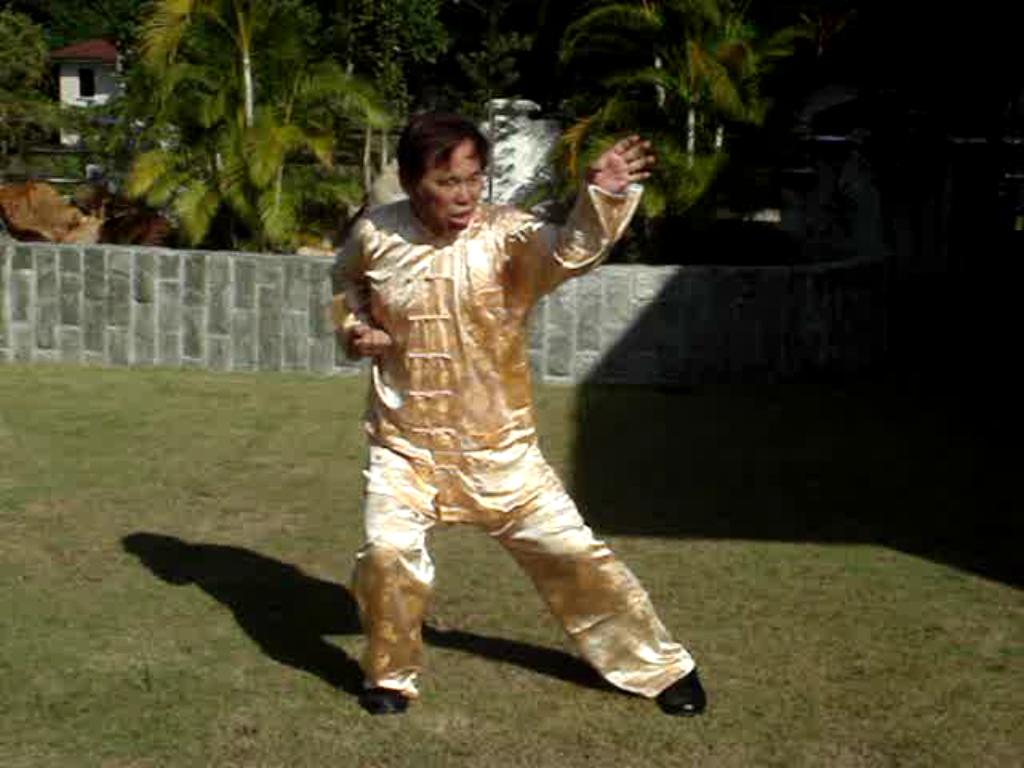
How is Grandmaster Wong able to deflect an attack when he is not looking at it? The secret lies within the set, "Cham Kiew".
Click here to enter.
Phew Chee or Thrusting Fingers
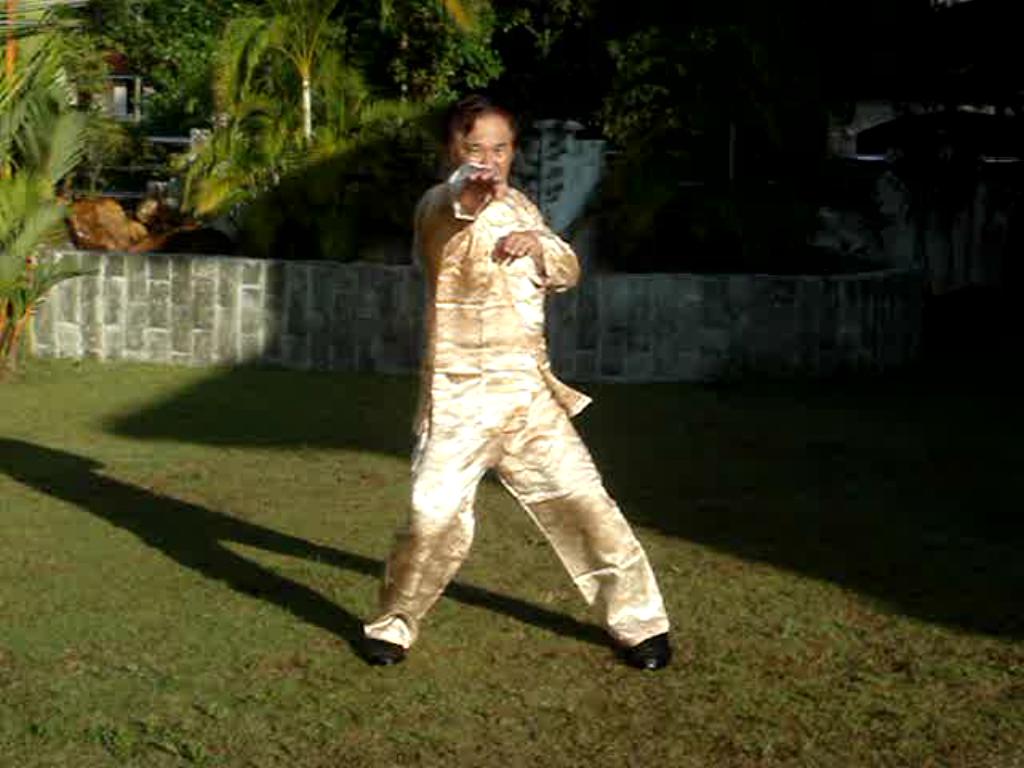
"Phew Chee" which means "Thrusting Fingers", is a good example of profundity in simplicity. The set looks simple, but is very profound in combat application.
Click here to enter.
Stances and Forms
Reviewing the Basic Stances

Grandmaster Wong reviews the basic stances and highlight the crucial points of each stance.
Click here to enter.
The Form-Level of Siu Lin Tou
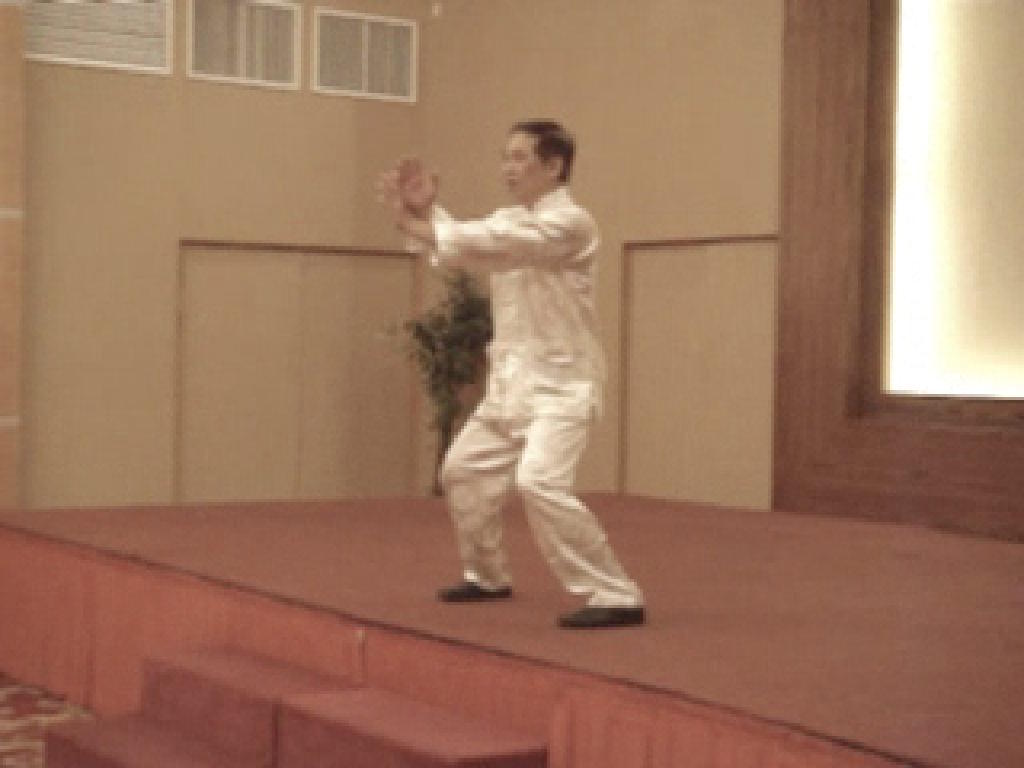
Grandmaster Wong leads course participants to perform Siu Lin Tou at the form level. The video clips here show Grandmaster Wong performing the set as a mirror image of the participants.
Click here to enter.
Internal Force with Siu Lin Tou
Using Energy Flow to Move Form
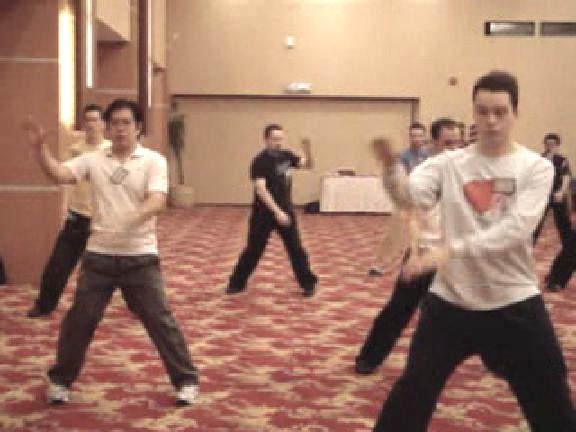
Having attained reasonable proficiency at the form level of Siu Lin Tou, course participants progress to the energy flow level. Grandmaster Wong teaches them how to use their energy flow to direct the forms of Siu Lin Tou without using muscular strength.
Click here to enter.
Energy-Flow Level of Siu Lin Tou
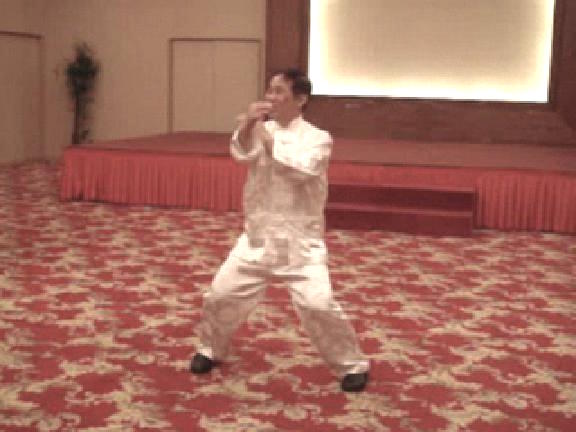
Grandmaster Wong teaches the course participants how to use their mind to direct energy flow, which in turn directs the movements of form. The whole set is performed in chi flow without the use of muscles.
Click here to enter.
Converting Energy Flow to Internal Force
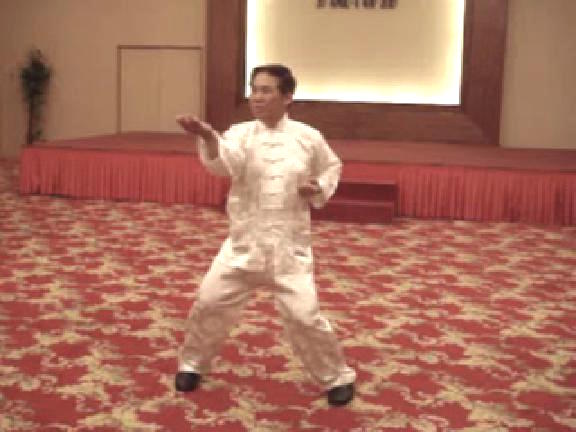
This is the internal force level where energy flow is converted to internal force. First, participants perform Siu Lin Tou in energy flow. Then the energy flow is converted to internal force. It is important not to confuse internal force training with isometric exercise.
Click here to enter.
Internal Force Level of Siu Lin Tou
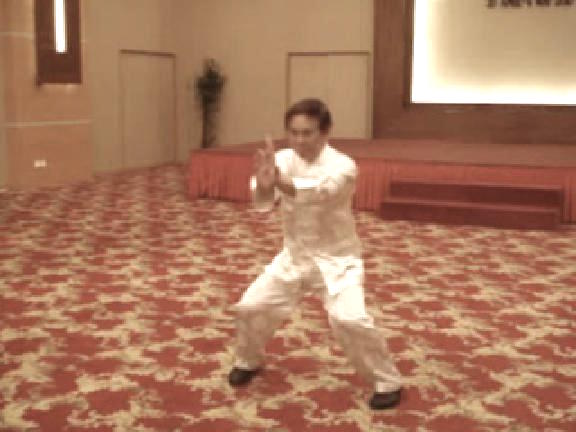
Course participants convert energy flow into internal force, and perform Siu Lin Tou at the internal force level. Grandmaster Wong then teaches the course participants to "fa-jin", or explode force, using the pattern "Weaving Flower Hands".
Click here to enter.
Hard and Soft Internal Force
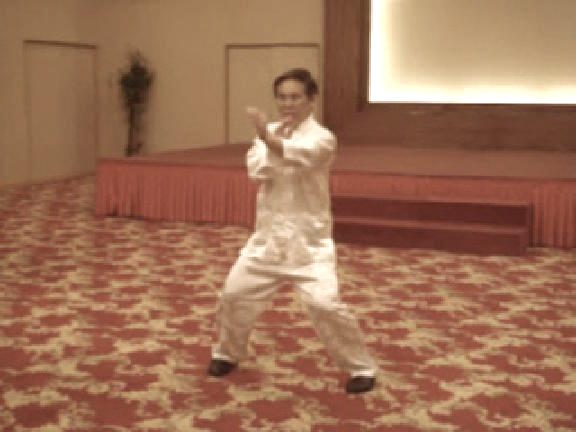
Internal force may be "hard" or "soft", and also may be developed using the hard approach or the soft approach. The nature and the developmental approach are not mutually exclusive.
Click here to enter.
Chi Sau or Sticking Hands
Introduction to Chi Sau
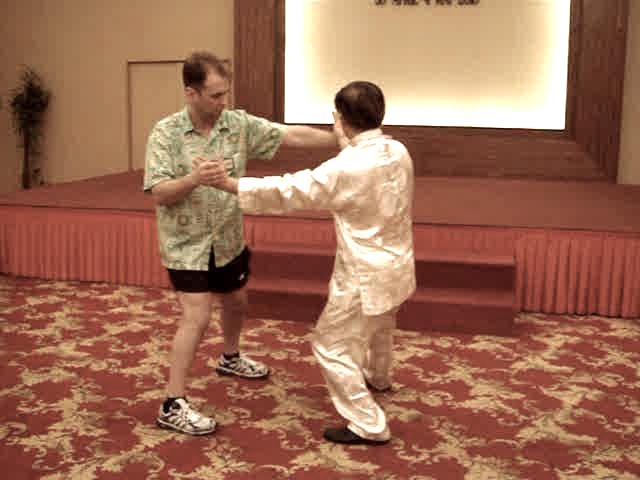
This is the introduction to Chi Sau, or Sticking Hands. Course participants pactice the basic hand movements, namely Covering Hands and Circling Hands. The onus of the practice is to let energy flow without using muscular tension.
Click here to enter.
The Importance of Waist Rotation
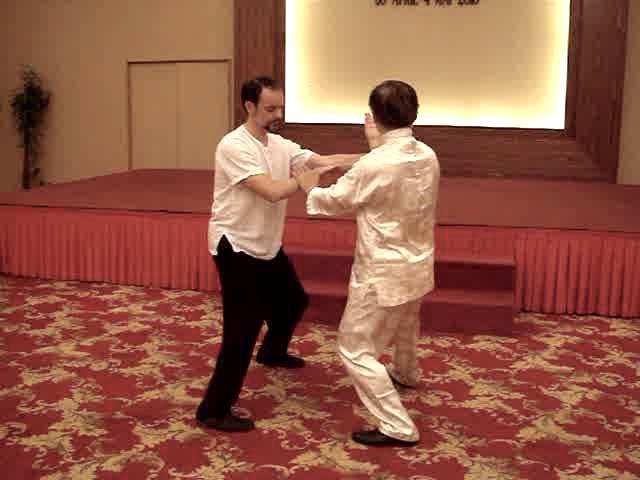
Waist rotation is a very important aspect of Wing Choon Kungfu. Grandmaster Wong explains that even without internal force but with proper application of waist rotation, a small-sized exponent can effectively handle a bigger-sized opponent.
Click here to enter.
Phong Sau and Kham Sau against Middle Attacks
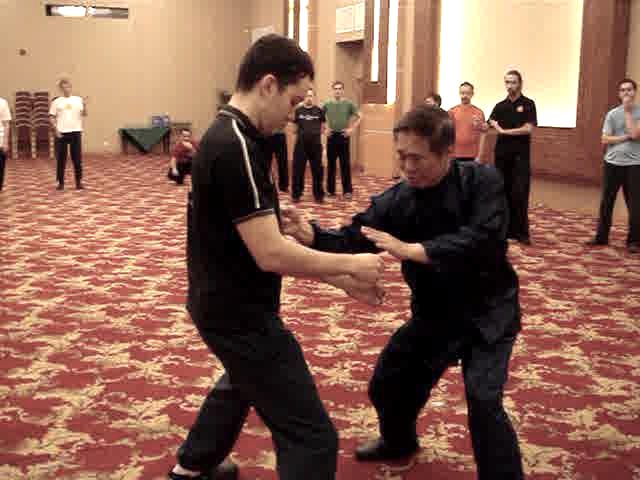
Phong Sau or Supporting Hand is an interesting technique and is frequently used in Wing Choon Kungfu. It is not a block; its effectivness comes waist rotation which deflects an opponent's middle attack, with the defenders hand acting as a guard or support.
Click here to enter.
Low Attacks and their Defences
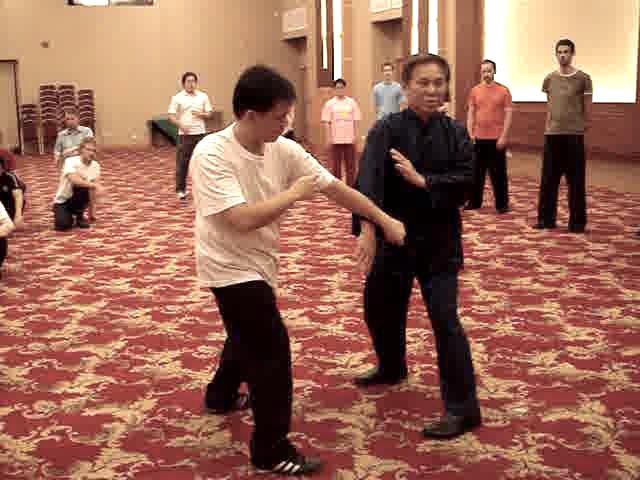
Fan Chap or Reverse Jab is a formidable low attack. Excellent defence against low attacks as well as middle attacks are Phong Sau and Kham Sau respectively. Instead of having a lot of techniques, Wing Choon Kungfu uses only a few skilfully.
Click here to enter.
Chiek Sau or Cutting Hand for Side Attacks
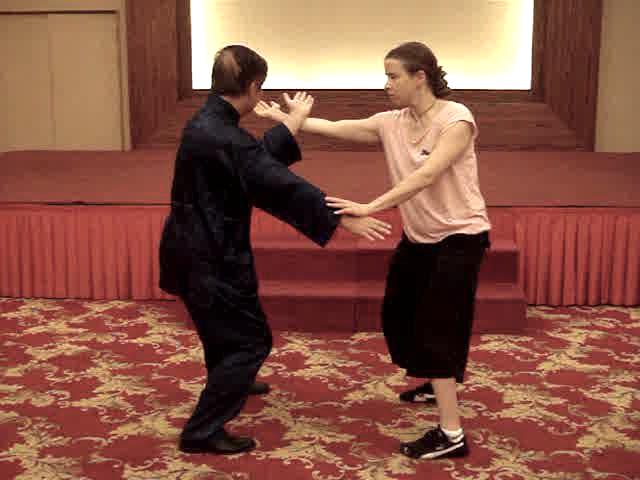
An effective side attack is Chiek Sau, or Cutting Hand. Good response iare Than Sau amd Kham Sau. Than Sau is not a direct block but a deflecting move using waist rotation using minimum force against maximun strength.
Click here to enter.
Cham Kiew or Searching for Bridge
The Form Level of Cham Kiew
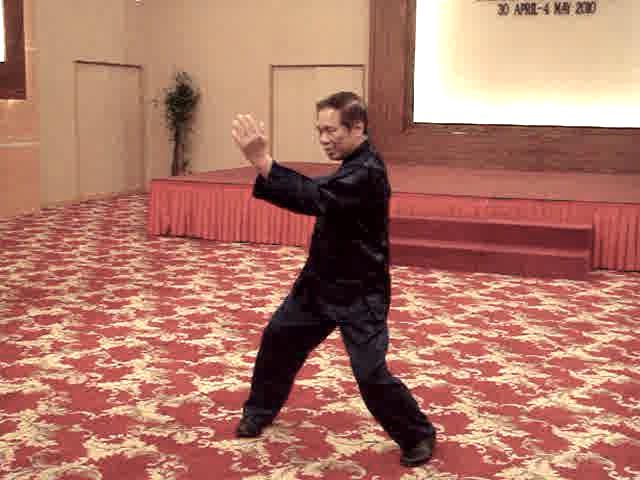
Cham Kiew, which means Searching for Bridge, is an excellent set for developing Chi Sau skills. The class reviews Siu Lin Tou by performing it in chi flow. Then Grandmaster Wong leads the class in performing the forms of Cham Kiew.
Click here to enter.
Using Energy to Direct Form, and Converting Energy to Internal Force
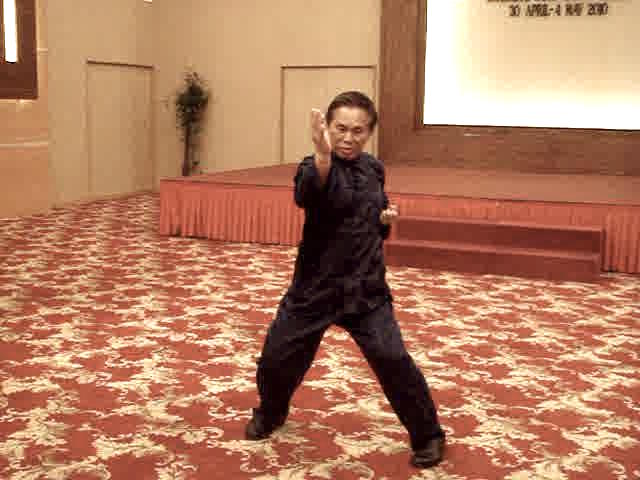
Having attained a good standard in performing Cham Kiew in picture-perfect form, the class proceeds to perform the set in energy flow, and then convert the energy to internal force.
Click here to enter.
Wing Choon Combat Sequence
Sequence of Attacks and Counters
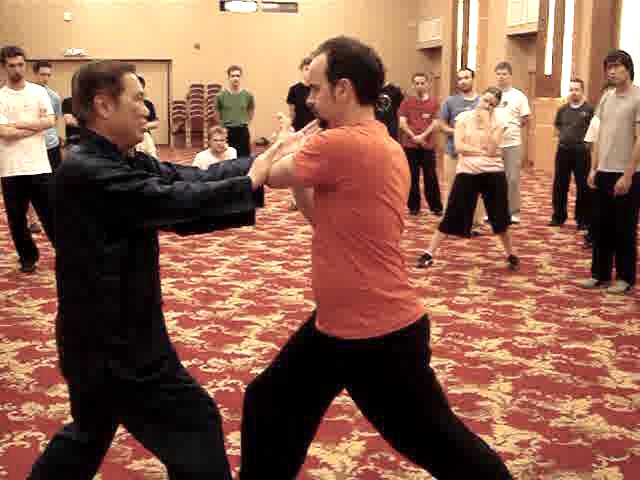
Having learnt the basic techniques in Chi Sau, the class proceeds to learn apply the techniques in combat. Grandmaster Wong illustrates a simple sequence of attacks and their counters.
Click here to enter.
Applying Wing Choon Patterns for Combat
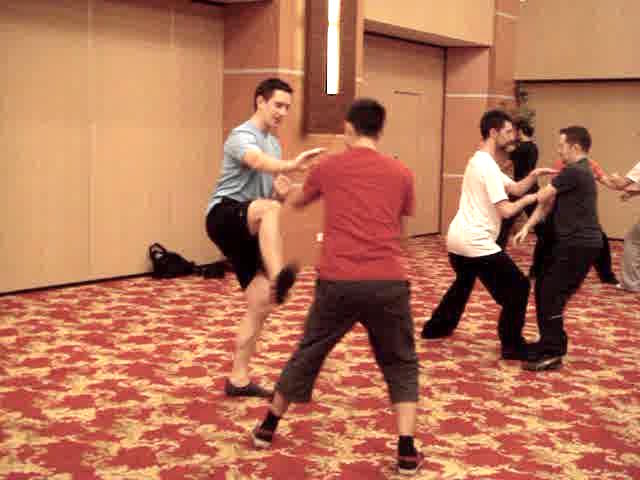
Grandmaster Wong shows the class how to construct a combat sequence using Wing Choon patterns. Some techniques often catch opponents by surprise. As usual the class is full of fun and laughter.
Click here to enter.
Developing Sensing Skills
Basic Hand Techniques of Stationary Chi Sau
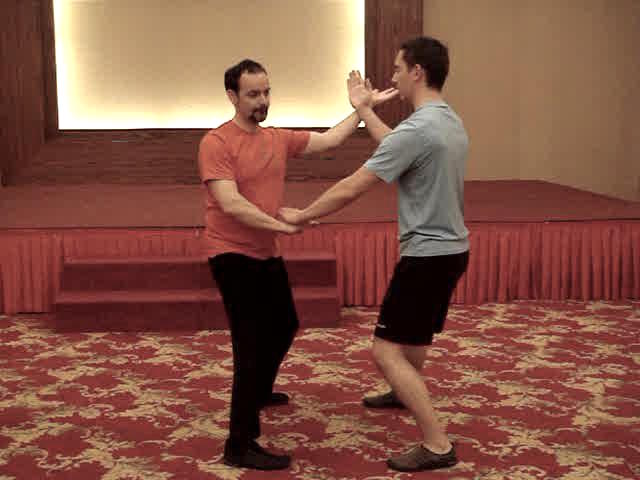
Sifu Tim Franklin and Sifu Robin Gamble review all the basic hand techniques of attack and defence. These techniques cover all the four levels of top, middle, bottom and sides, and include theleft mode and the right mode, as well as the out-gate approach and the in-gate approach.
Click here to enter.
Developing Thien Keng or Sensing Skills
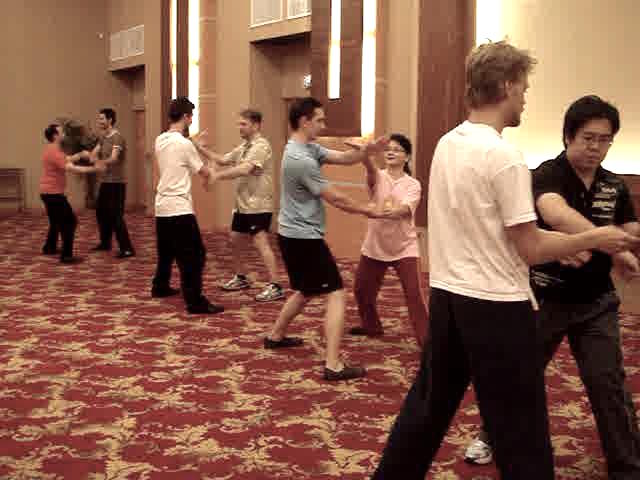
An important purpose of chi sau training is to develop "thien keng", which literally means "listening force", and refers to special skills of sensing opponents' movements and intentions without having to look at them.
Click here to enter.
Training of Energy and Mind
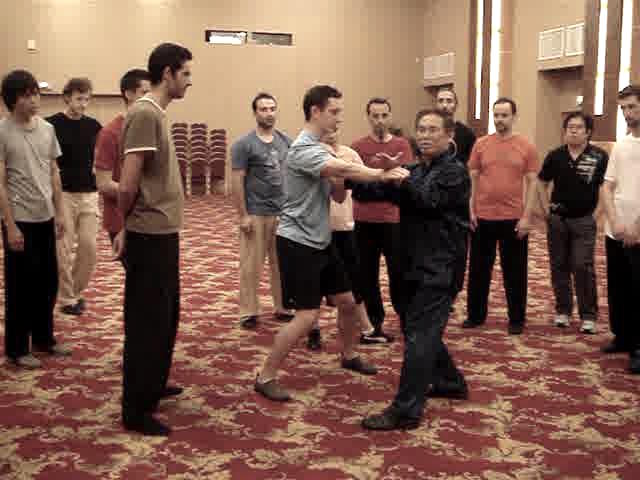
A unique feature of our school is that whenever we practice kungfu, we are also practicing chi kung and meditation. Course participants enjoy some interesting chi flow followed by standing meditation after chi sau practice.
Click here to enter.
The Use of Tactics
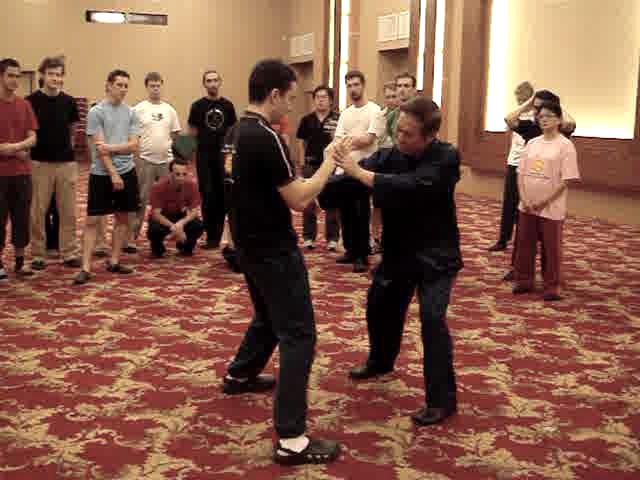
As the course participants improve their skills in chi sau, they soon discover that it is easy to deflect opponents' attacks. This leads finding new ways and means to defeat opponents. An excellent progression is to move from techniques to tactics.
Click here to enter.
Sensing with the Mind
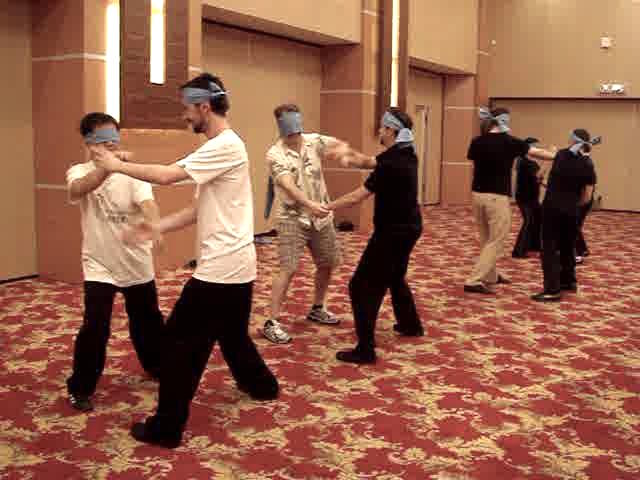
Course participants practice chi sau while being blind-folded. Grandmaster Wong has also taught them to sense with their mind. Hence they have developed non-contact sensing skills.
Click here to enter.
Sap Luk Sau or Sixteen Hand Techniques
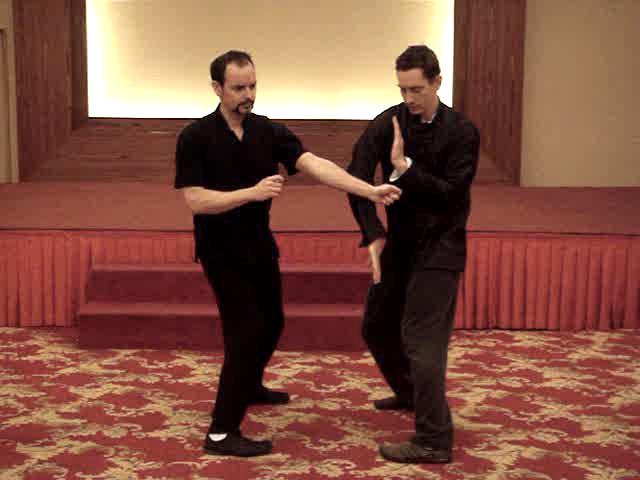
Grandmaster Wong have compiled all fundamental chi sau techniques into three basic sets. This is the first set and is called "Sap Luk Sau" or "Sixteen Hand Techniques".
Click here to enter.
Performing Sap Luk Sau Blind-Folded
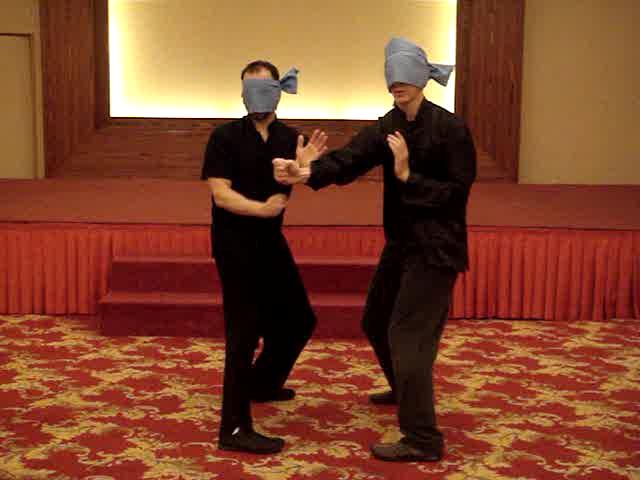
Sifu Tim Franklin and Sifu Robin Gamble perform Sap Luk Sau blind-folded. It is interesting that their movements and responses are more spontaneous and fluid.
Click here to enter.
Free Movement Chi Sau in Blind-Fold
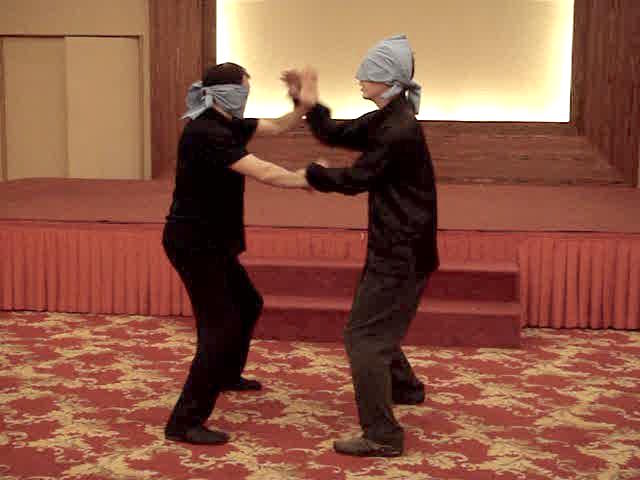
Sifu Robin and Sifu Tim proceed to perform chi sau in free movements, that is, without any pre-arranged routine. They sense their opponents not only with their hands but also with their mind.
Click here to enter.
Hand Techniques in Chi Sau
Taming or Locking an Opponent and Simultaneouly Striking Him
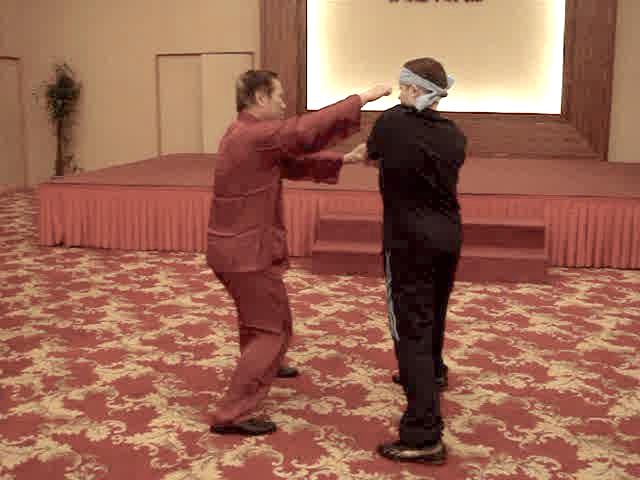
An effective attacking tactic is to tame or lock your opponent's hands and simultanously strike him. You can imagine how combat effective you will be if you spend some time mastering this tactic.
Click here to enter.
Excellent Counters Proposed by Course Participants

How would you counter if an opponent tames or locks your two hands and simultaneously attacks you? It is remarkable that just after about 10 minutes working together, many particpants come out with excellent counters.
Click here to enter.
Exploiting Opponents' Weaknesses in Combat

There are, however, some weaknesses in some counters, and Grandmaster Wong takes the opportunity to explain the weakness and provide remedy. Many martial artists today make similar weaknesses in their sparring and fighting, and you should exploit them to your advantage.
Click here to enter.
When you are being Locked and Pressed against a Wall

If your opponent merely tames your hands, you can defelct them away by rotating your waist as you execute a counter-strike. But if he is gripping you, you have to release his grip. Suppose you cannot move back, like when you are being pressed against a wall. What could you do?
Click here to enter.
Moving from In-Gate to Out-Gate
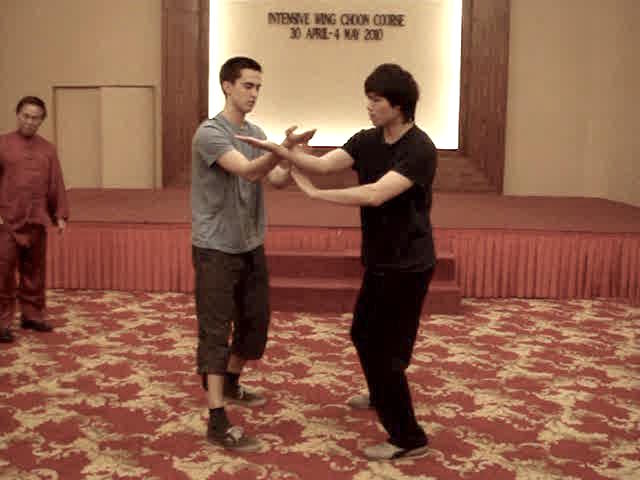
In-gate and out-gate refer to our hands in relation to an opponent's hands. We may start with an in-gate position and move to an out-gate strike. Why do we pay attention to being in-gate or out-gate? It is because we can gain various advantages if we know how to exploit these situations.
Click here to enter.
Effective Counters against Grips and Locks
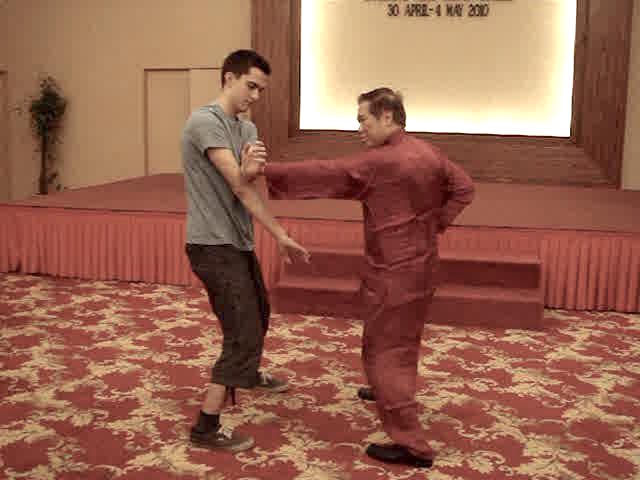
A small-sized exponent would be in a great disadvantage if a bigger-sized opponent grips or locks him. But Wing Choon Kungfu is such a sophisticated art that it can turn weaknesses into strength. There are many effective techniques in Wing Choon Kungfu to counter grips and locks.
Click here to enter.
No Defence Direct Counters against Formidable Bottom Attacks
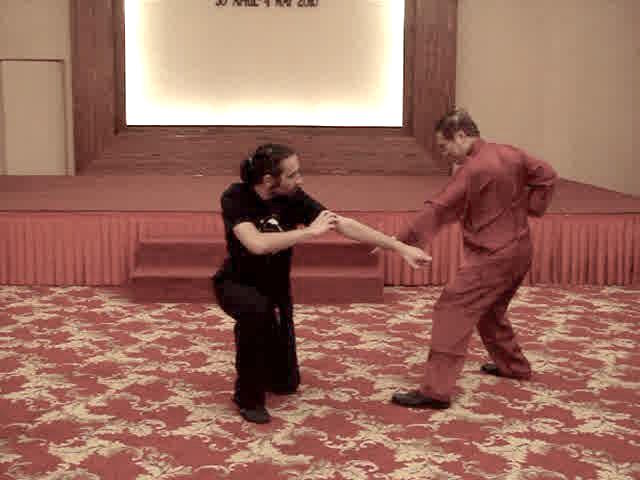
If you distract your opponent with some movements on top and strike his dan tian with a reverse palm, it often catches him off guard. Or if you lock his two arms on top, then suddenly execute a reverse leopard punch to his groin, he often does not know what to do. The counters are quite simple and effective -- if you know how.
Click here to enter.
Horizontal Chops and Crane Beaks in Side Attacks
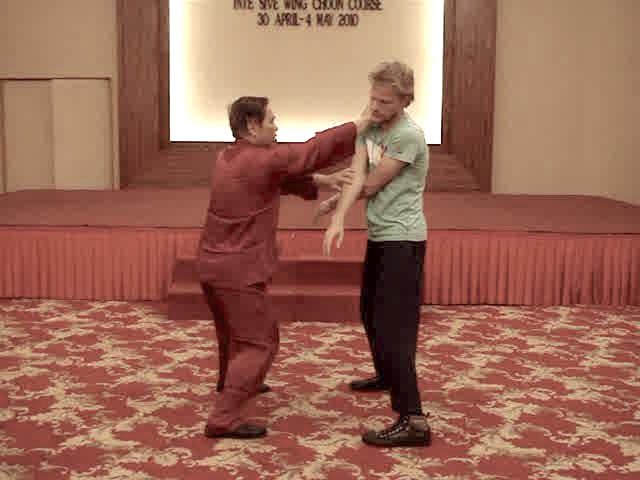
After gripping or locking an opponent, you may execute a side attack using a horizontal chop or a crane beak. An effective counter against them is a sideway or diagonal chop, striking the attacker's arm or wrist using the tactic of "no defence direct counter".
Click here to enter.
Top and Middle Attacks and their Counters
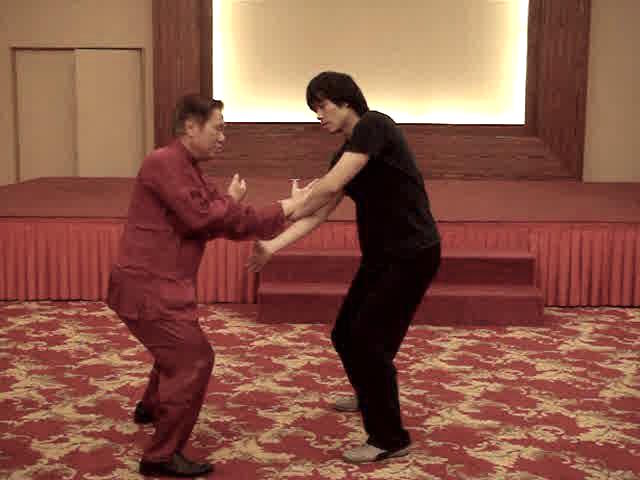
Max and Jonathan review the various methods of taming and locking an opponent’s hands, and simultaneously attacking him, and their appropriate counters. Grandmaster Wong explains some finer points, like the rotation of the waist and the tactic of "no defecne direct counter".
Click here to enter.
Bottom and Side Attacks and their Counters
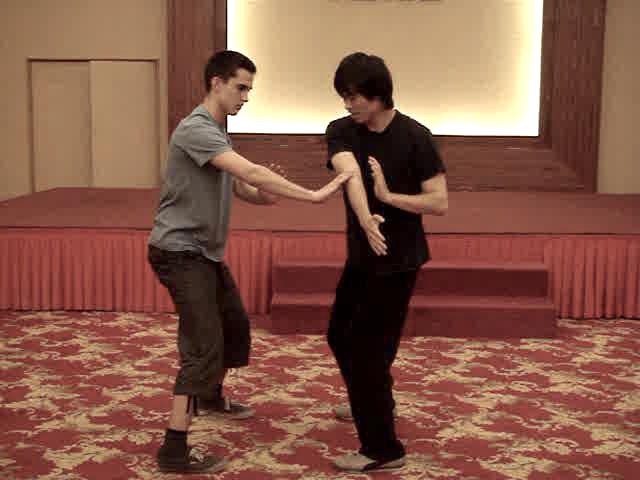
There are some noticable differences between Choe Family Wing Choon and popular styles of Wing Choon many people practice today. Many Wing Choon practitioners today focus on top and middle attacks, and seldom use bottom and side attacks. But bottom and side attacks are frequently used in Choe Family Wing Choon.
Click here to enter.
Phew Chee and Free Sparring
Learning the Forms of Phew Chee
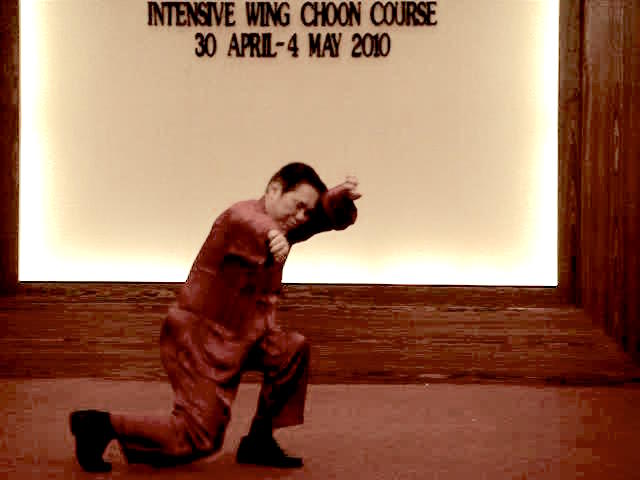
Phew Chee is the thrid fundamental set in Wing Choon Kungfu. The techniques look simple, but are very sophisticated in their application. Two notable features of this set are the phoenix-eye fist and the leopard fist. They are excellent hand-forms for small-sized exponents against bigger-sized opponents.
Click here to enter.
From Pattern Practice to Free Sparring
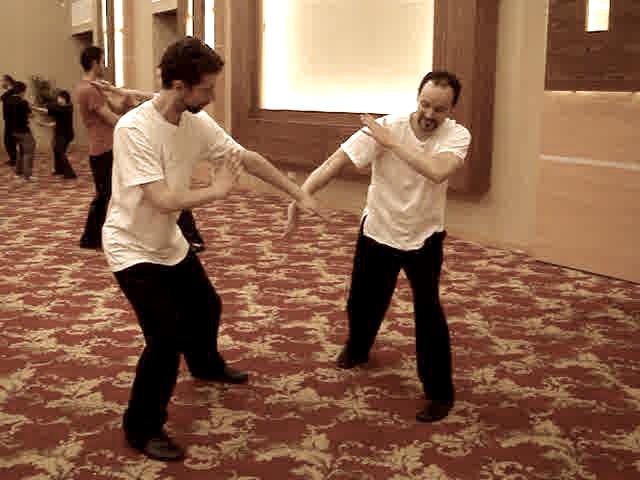
A big problem facing many kungfu practitioners today is their inability to appy the kungfu patterns they have learnt in set practice in free sparring or real fighting. We are very lucky to have overcome this problem. The video clips here show three crucial stages in our sparring methodolgy.
Click here to enter.
Kicking Techniques in Chi Sau
Thrust Kicks and their Counters
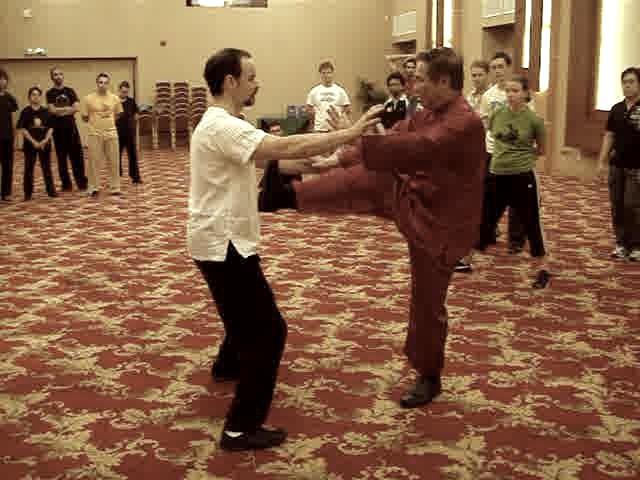
As the founder of Wing Choon Kungfu, Yim Wing Choon was an elegant lady wearing skirt, Wing Choon kicks are seldom high. The thrust kick is often used. Here Grandmaster Wong demonstrates how to open and to close an opponent while executing the kick. An effective counter is the hand sweep.
Click here to enter.
Smart Practice Makes Perfect
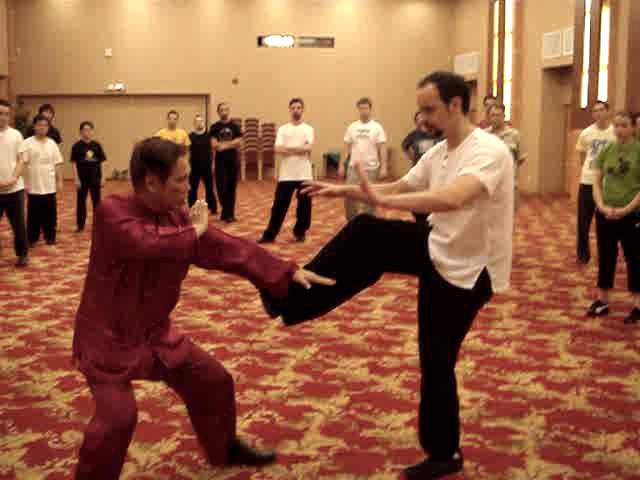
A common mistake many kungfu student makes is to think of what kungfu technique to use when an opponent attacks. In combat often there is no time to think. Then how can we respond correctly and spontaneously to an opponent's random attacks? The secret lies in "Smart Practice Makes Perfect".
Click here to enter.
Understanding Wing Choon Principles and Practice
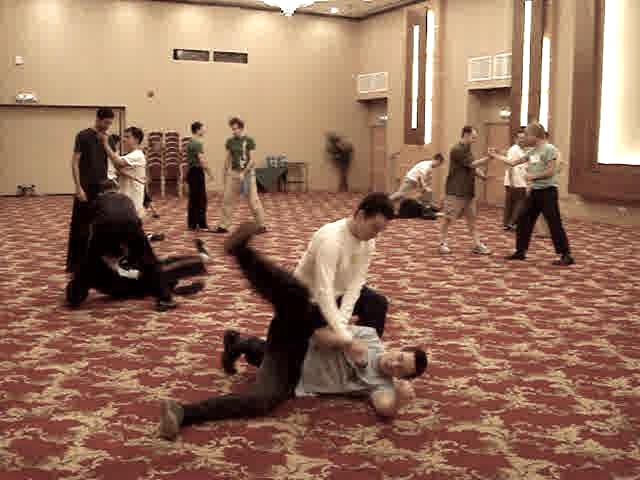
Wing Choon Kungfu is a complete art covering all the four categories of attack and defence. Grandmaster Wong asks the course participants which patterns in Siu Lin Tou could be used to fell opponents. They also discuss and work out important Wing Choon principles and practice.
Click here to enter.
Practicing Chi Sau while being Blind-Folded
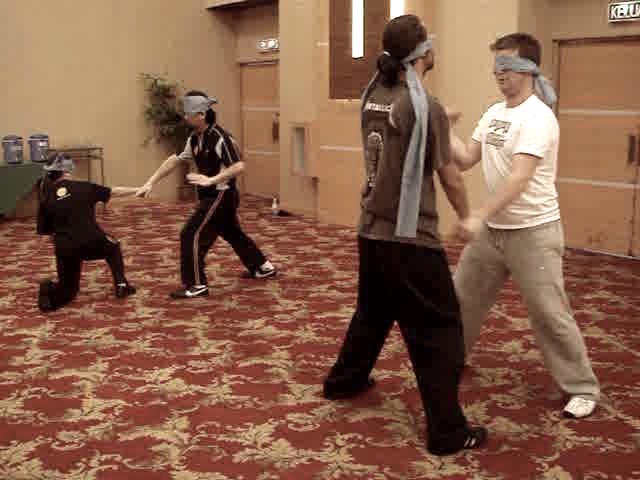
An invaluable part of the course is learnig the very special skill of deflecting opponents' attacks without looking at them. Grandmaster Wong shares the secrets of this skill, known as "thien keng" or "sensing skill", systematically with the course participants.
Click here to enter.
Effective Counters against Kicks
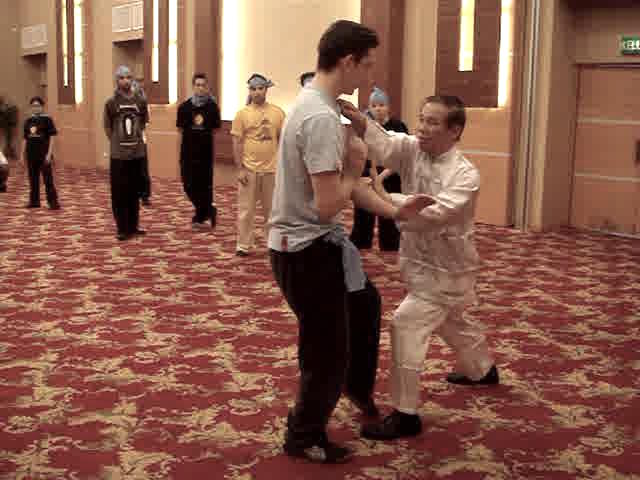
It is easy to defeat an opponent using a kick. Move your stance backward a small step to avoid the kick and simultaneously strike his kicking leg. As he drops it on the ground, move forward with a strike to a vital area. But if you are the one executing a kick, how would you respond to these counters?
Click here to enter.
Cockerel Kicks against Whirlwind Kicks
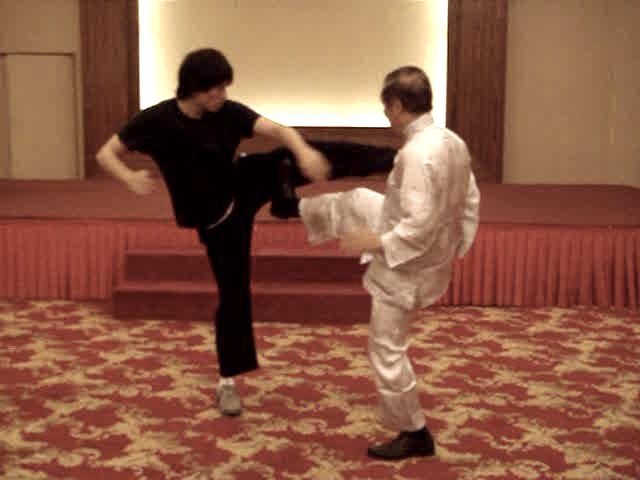
Grandmaster Wong asks course participants to work out amongst themselves how to counter the formidable whirlwind kicks. The answers are excellent, including the use of plough hands, raised knee, low strikes and felling the opponent.
Click here to enter.
Counters against Low Sweeping Kicks
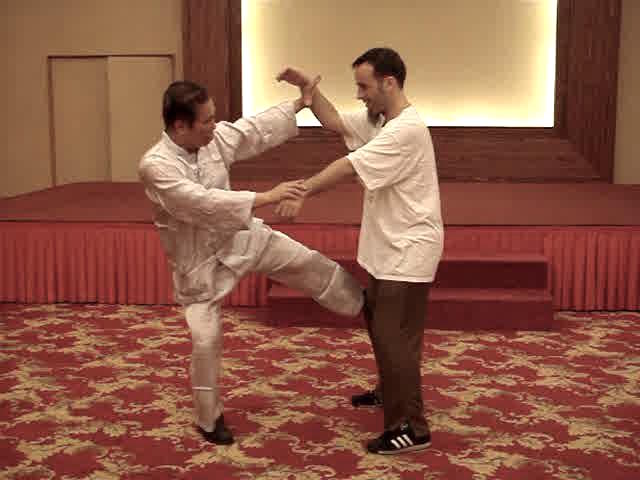
The low sweeping kick is a popular attack often used by Muay Thai fighters and Kick-Boxers. How would you counter such a kick. Course participants come out with some good answers.
Click here to enter.
Striking or Intercepting Opponents' Kicks
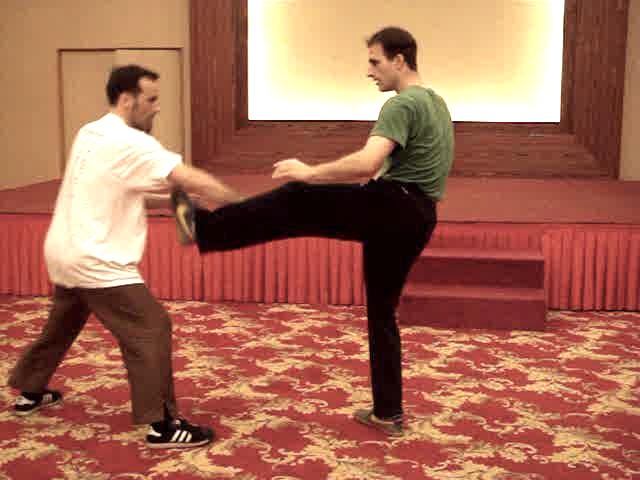
Sifu Joshua and Sifu Ronny review the various kicks and their counters. Against straight kicks, chop at the kicking legs with hand sweeps or chooping hands. If the kicks are circular, intercept with Cockerel Kicks.
Click here to enter.
Sap Ye Theak or Twelve Kicks
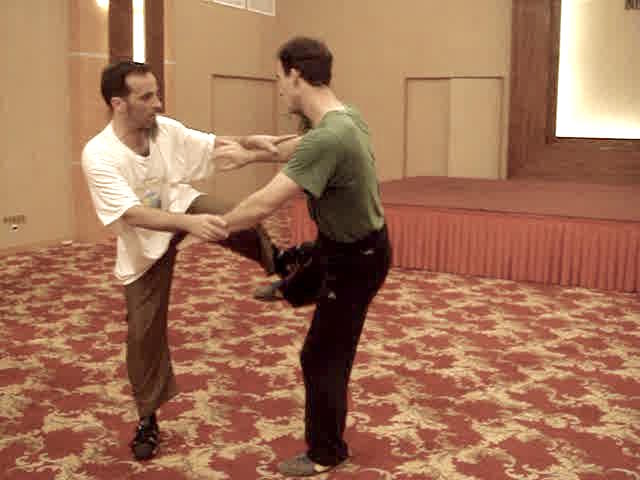
This is the second of three chi sau sets Grandmaster Wong has composed to enable course participants learn fundamental chi sau techniques more effectively. It is called "Sap Ye Theak" or "Twelve Kicks", because each practitioner of the chi sau set makes 12 kicking attacks.
Click here to enter.
Helping One Another and Having Fun
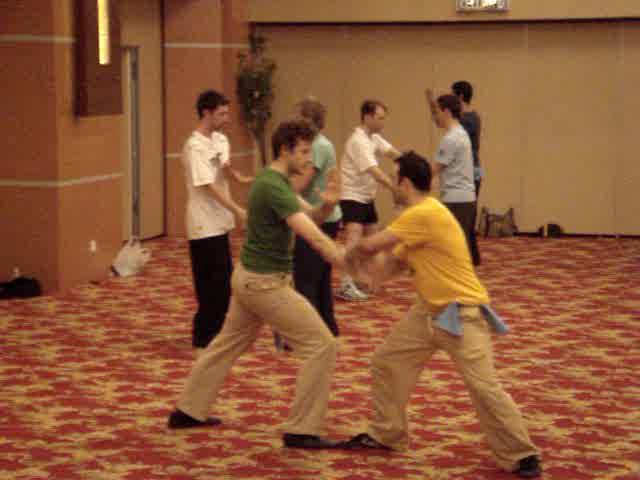
After Sifu Joshua and Sifu Ronny have completed the review of varios kicks and their counters, the course participants practice the newly learnt techniques. They help one another and have a lot of fun. Indeed, some people have expressed surprise that there is not only no injuries sustained in our combat training, but it is also filled with laughter.
Click here to enter.
How do you Escape this Difficult Situation
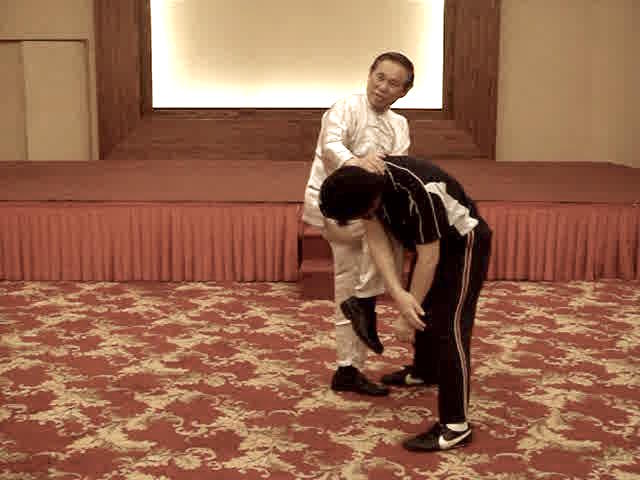
Grandmaster Wong shows a sophisticated attack similar to the formidable Muay Thai knee strike. Yet the course participants provide many effective counters. Finally Granmaster Wong shows a counter using the familiar Wing Choon "Cockerel Kick".
Click here to enter.
Felling and Chin-Na Techniques
Felling a Giant Almost Effortlessly
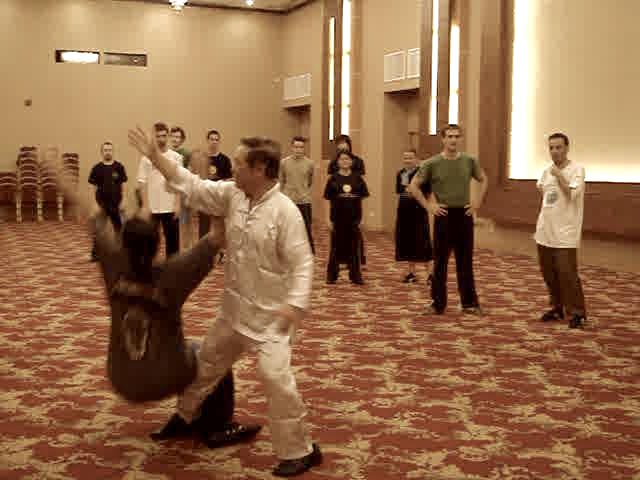
As Wing Choon Kungfu is meant for small-sized exponents, felling huge opponents must exploit the principle of "minimum force against maximum strengthâ". Grnadmaster Wong shows how you can fell a giant almostly effortlessly! Course partiipants have some fun working out counters to the felling techniques.
Click here to enter.
Turning a Weakness into a Strength
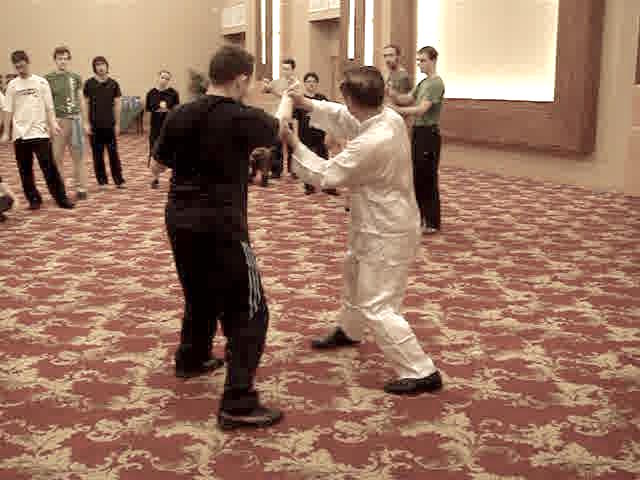
If all other things were equal, chin-na is the nemesis of Wing Choon Kungfu. But a good Wing Choon practitioner can turn a weakness into a strength. This is what Grandmaster Wong asks the course participants to do. He shows them a formdiable chin-na technique and ask them work out the counters on their own.
Click here to enter.
Butterfly Palms against Double-Grip Chin-Na Attack
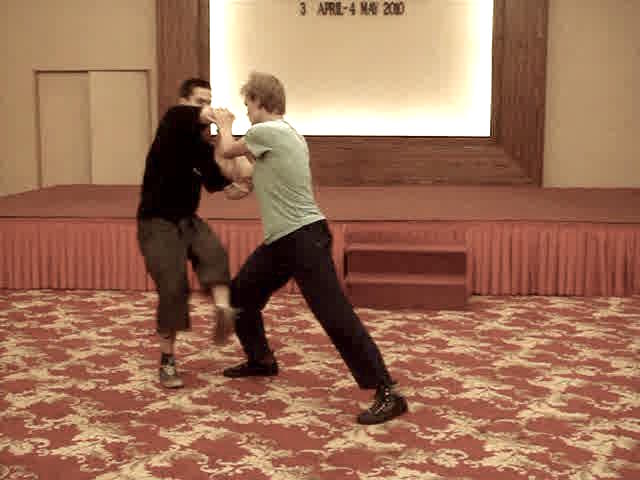
Grandmaster Wong makes the attack situaion more difficult. Now he applies a double grip on an opponent's arm instead of a single grip on his elbow. How would you counter this double-grip chin-na technique. Again the course participants come out with excellent counters.
Click here to enter.
Sophisticated Applications from Innocent-Looking Patterns
Do you Know the Combat Applications of these Apparently Useless Patterns?
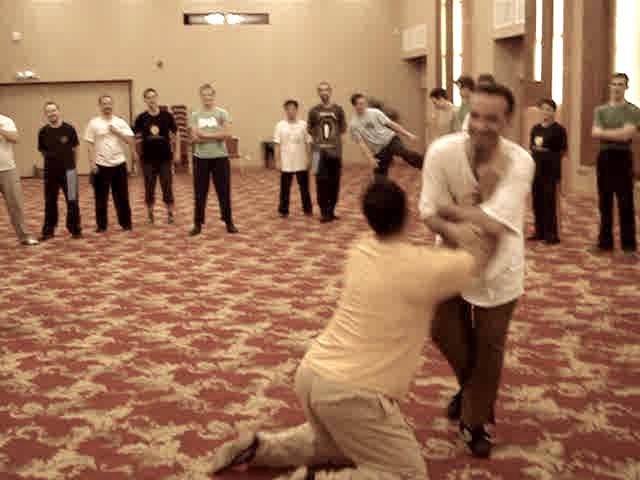
Some of the Wing Choon patterns in Siu Lin Tou appear to have no combat functions. Some examples are "Double Press Palms", "Folding Arms", "Scissors Hands" and "Monkey Paws". Can you think of any combat functions for them?
Click here to enter.
Sophisticated Applications of Seemingly Harmless Patterns
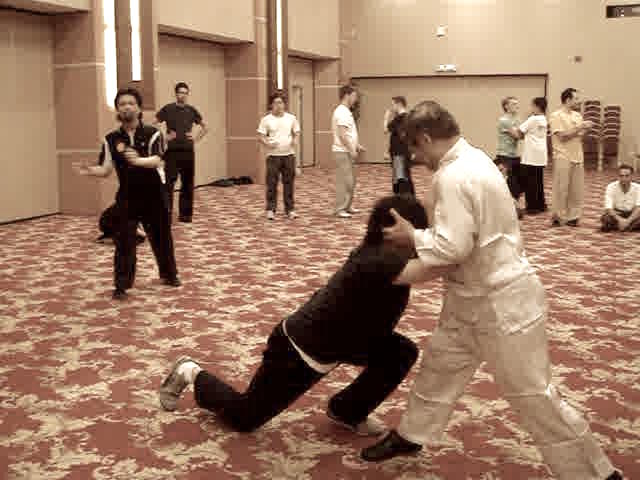
Kungfu forms were not invented, but evolved from actual fighting. Because they have evolved over a long time to become sophisticated, their combat functions may not be obvious to the uninitiated. Course participants have a rewarding time working out their combat applications.
Click here to enter.
Have Fun Dicephering Sophisticated Applications from Innocent-Looking Paterns
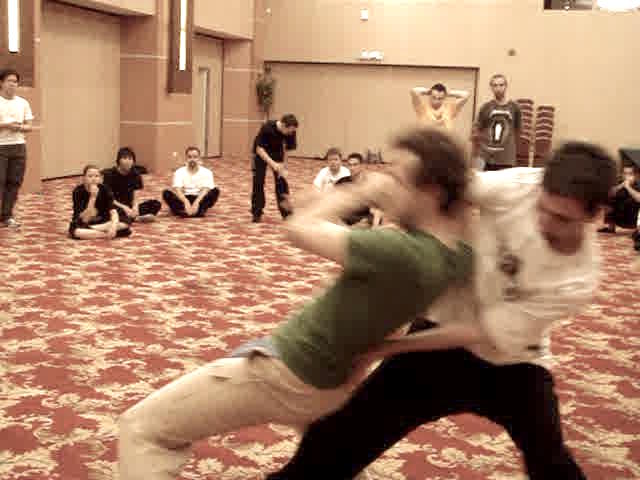
The fun continues with course participants deciphering combat applications from seemingly harmless patterns. For some fun, can you tell from where in Siu Lin Tou Sifu Tim takes his effective sequence of continuous attacks, or Sifu Mark takes his technique of a backward throw?
Click here to enter.
Big and Small Movements in Wing Choon Hand Techniques
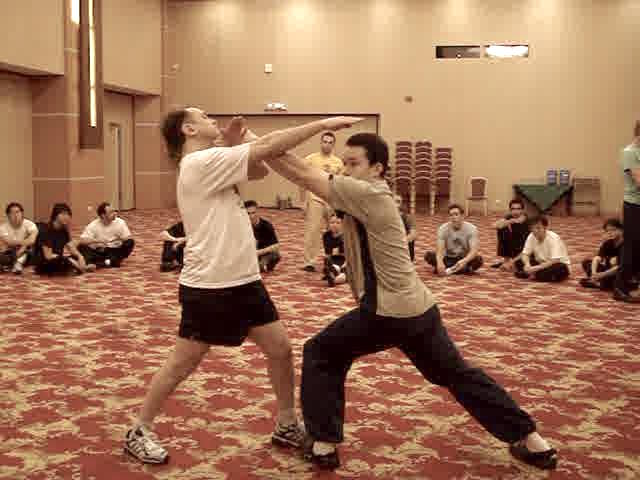
Wing Choon Kungfu is famous for its hand techniques – not just the big movements of the arm like mirror hand and support hand, but also small movements of the wrist, fingers and elbows, though these small movements are little understood by many Wing Choon students.
Click here to enter.
The Course is Full of Interesting Surprises
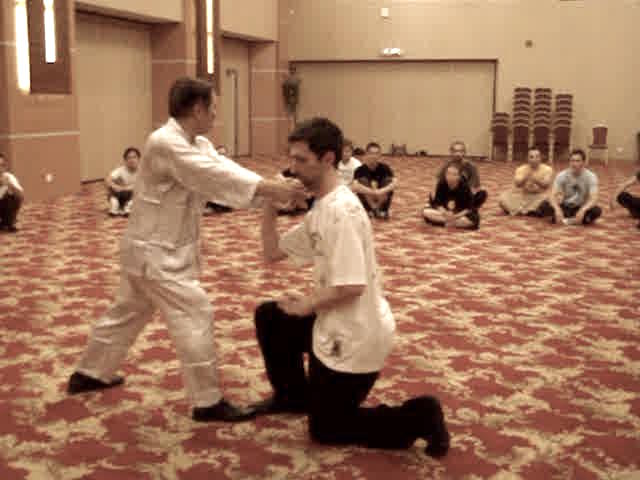
The course is often full of interesting surprises. Grandmaster Wong asks course participants to work out counters to some difficult attacks.
Click here to enter.
Felling, Knee Jabs and Gripping
Felling Techniques in Wing Choon Kungfu
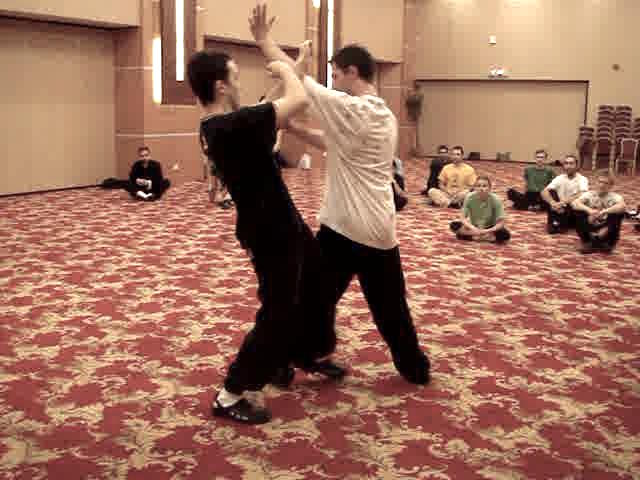
Some people think that there is no felling technique sin Wing Choon Kungfu. Of course there are, or else Wing Choon Kungfu would not be a complete art. But the felling techniques are hidden in the open.
Click here to enter.
Neutralizing Opponents' Attacks with your Legs!
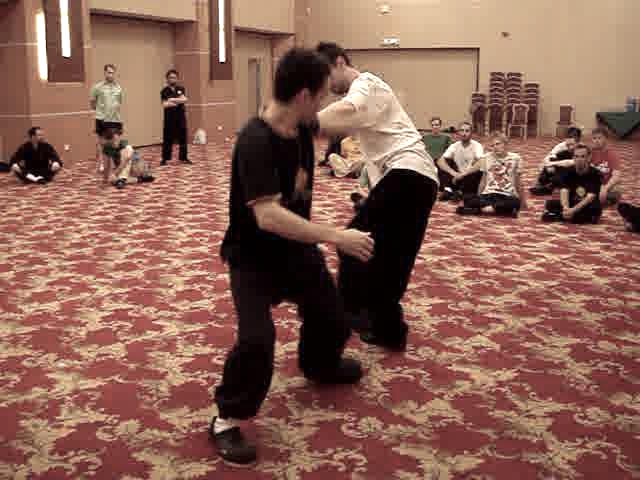
The examples here illustrate an important saying in Wing Choon Kungfu: "kiew lei kiew seong ko, kheuk lei kheuk ha siew", which means "when bridge comes, go along the bridge; when leg comes, neutralize with leg".
Click here to enter.
Chin-Na Attacks and their Counters
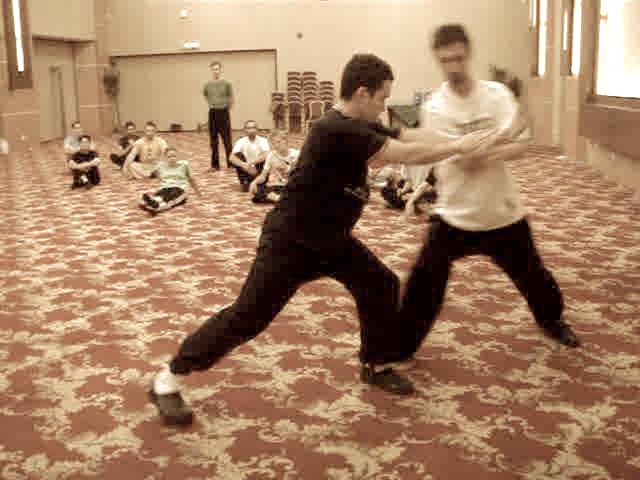
What would you do if both your wrist and elbow are gripped by a chin-na exponent? Two effective counters shown here are "Sinking Elbow" and "Butterfly Palms". Grandmaster Wong also shows some finer points of "Plough Hands", "Palm at Face" and "Cockerel Kick".
Click here to enter.
Theit-Cheit-Na or Fell-Knee-Grip
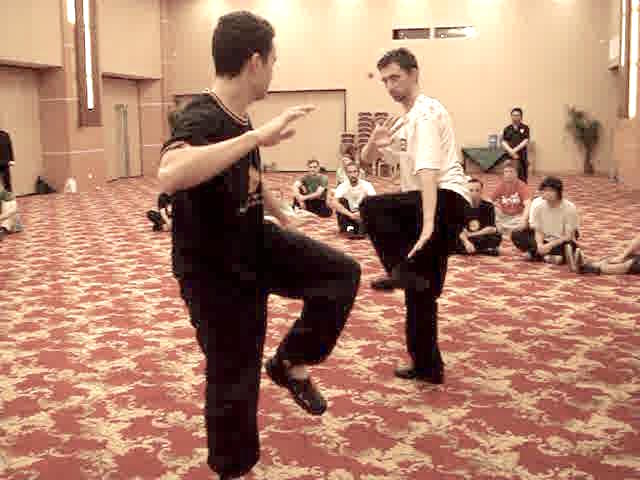
The various attacks and their counters are linked to form a set, called "Theit Cheit Na", or "Fell-Knee-Grip", which is a shortened form for "thiet fatt", "chong cheit", "cham na", meaning felling techniques, knee jabs and gripping techniques.
Click here to enter.
Using Minimum Force and Blind-Fold Sparring
How Elegant Ladies Can Handle Muscular Brutes
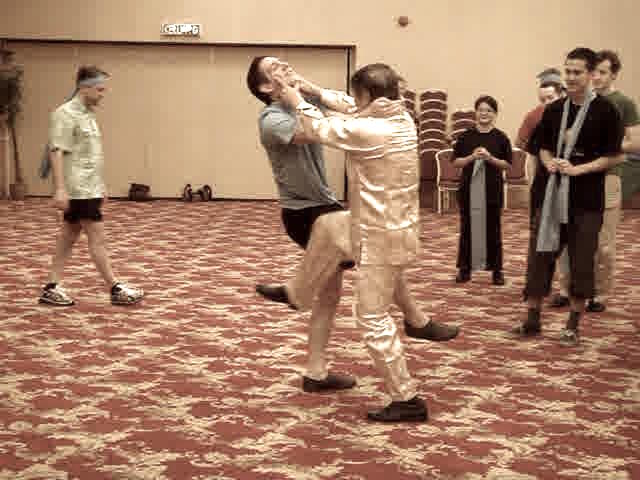
If you understand and apply Wing Choon principles, you still can handle bigger and stronger opponents even if you lack internal force. The video clips here show some examples, including how to handle the formidable knee strikes of a ferocious Muay Thai fighter.
Click here to enter.
Free Sparring while being Blind-Folded
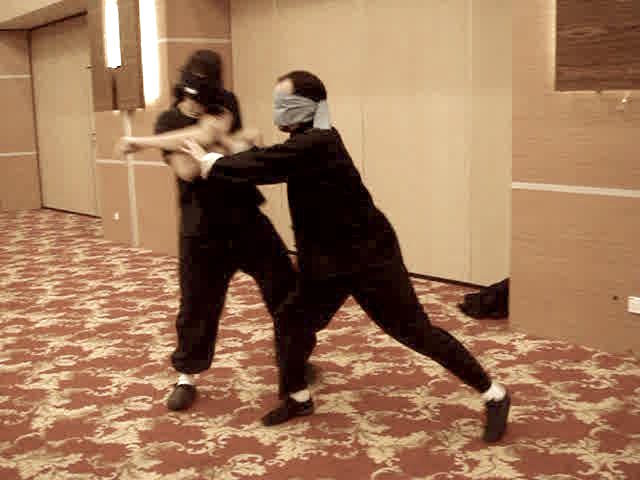
Course participants attempt free sparring while being blind-folded. They have to exercise much control so as not to hurt their sparring partners, especially when both are blind-folded. Also, as it is the first time they attempt free sparring while being blind-folded, their techniques and skills may not be optimum.
Click here to enter.
Deflecting Attacks Without Looking at Them
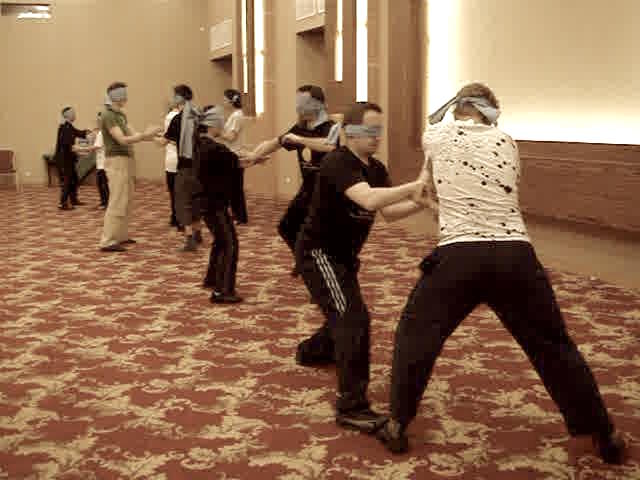
Grandmaster Wong keeps his promise that he would teach his special skills of being able to deflect attacks even without looking at them. Here they put their sensing skills into practice in free sparring while being blind-folded.
Click here to enter.
From Technique-Sparring to Sequence-Sparring
Moving from Technique-Level to Sequence-Level in Sparring
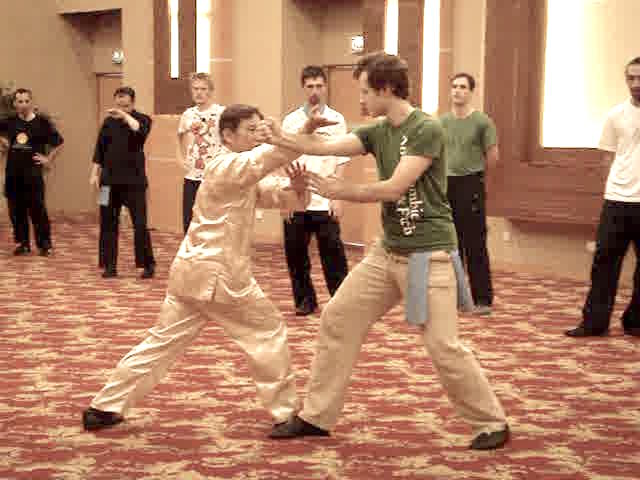
Course participants choose three suitable Wing Choon techniques and link them together to form a combat sequence, and apply this combat sequence on an opponent in pressing attacks.
Click here to enter.
Small Difference in Movements Can Make Big Difference in Results
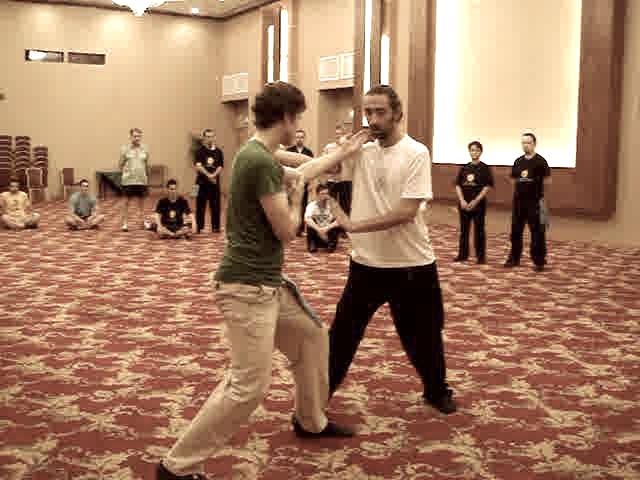
Grandmaster Wong points out some small differences in movements that make a big difference in results, like spacing and coverage.
Click here to enter.
Applying Planned Sequence Irrespective of Opponent's Response
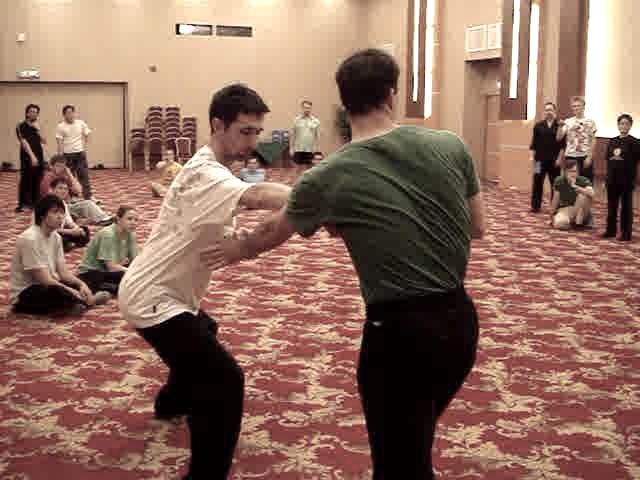
When you are well trained, you can apply the same sequence of attacks almost irrespective of how your opponent responds, as demonstrated by Sifu Ronny here.
Click here to enter.
Don't Hand your Defeat to your Opponent
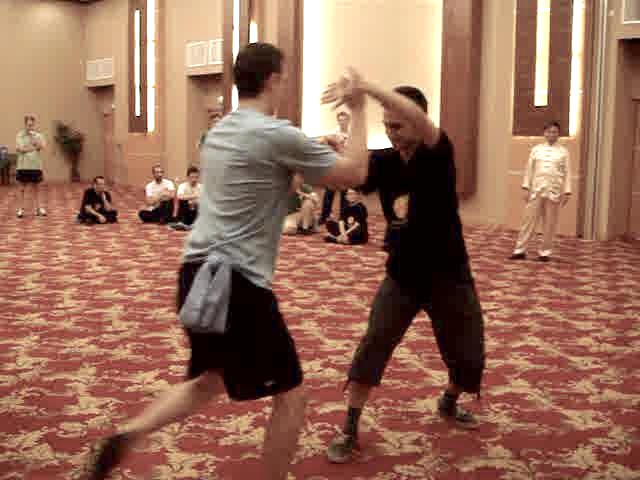
Without giving an opponent any advantage fulfills the first requirement of good combat, namely don't hand your defeat to your opponent.
Click here to enter.
Delving into Wing Choon Secrets
Marvelous Techniques Beget Marvelous Techniques
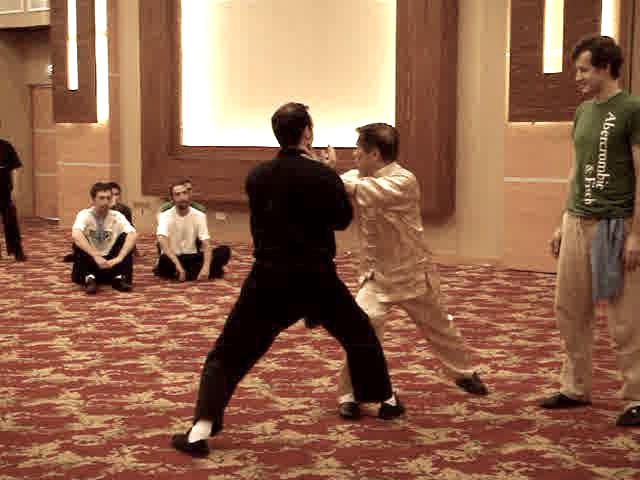
Grandmaster Wong shows how to counter this amazing technique, "Double Monkey Paws", using "Plucking Coconut", illustrating the Shaolin tenet of "marvelous techniques beget marvelous techniques".
Click here to enter.
Creating Opportunity to Defeat Opponent
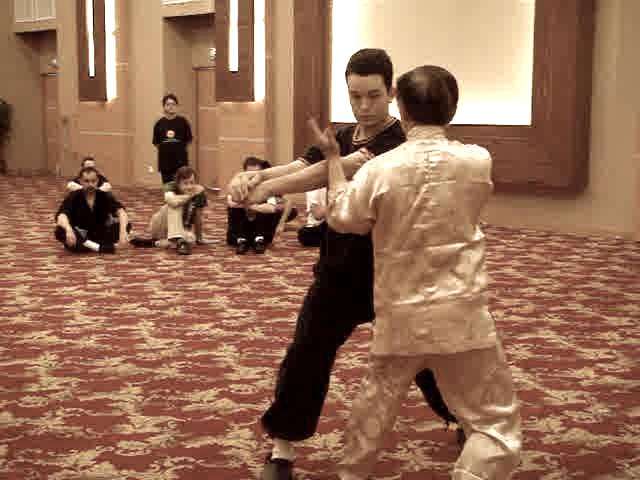
Grandmaster Wong shows how to gain an advantage over an opponent by moving to his side. This is creating opportunity to defeat the opponent.
Click here to enter.
Secrets of Crane Beak and Double Punch
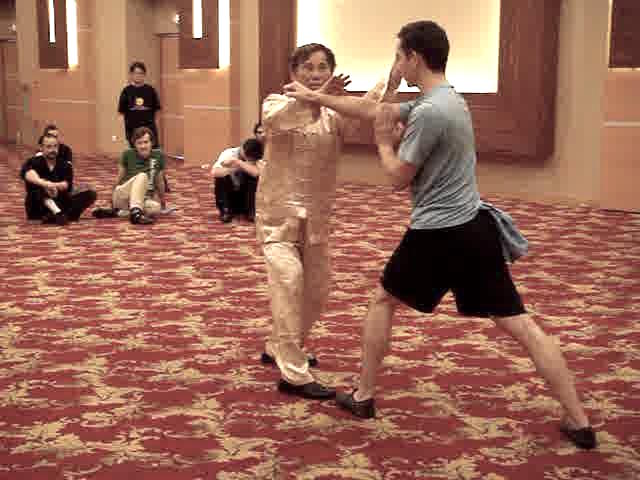
Those wondering how the Crane Beak can be used in combat would have an amazing example here. The counter against this attack using a Double Punch reveals another secret.
Click here to enter.
Open Secrets and Close Secrets
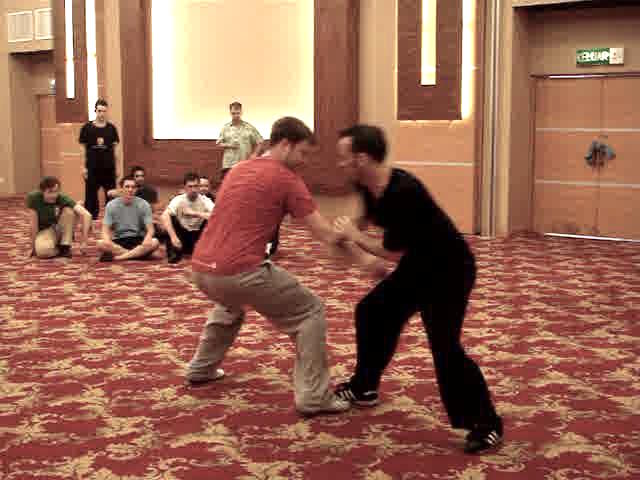
The sequence between Sifu Joshua and John reveals some secrets hidden in the open. Some close secrets are also explained by Grandmaster Wong. Course participants please remember that these are close secrets should not be revealed to outsiders.
Click here to enter.
Secrets of Sequence Sparring
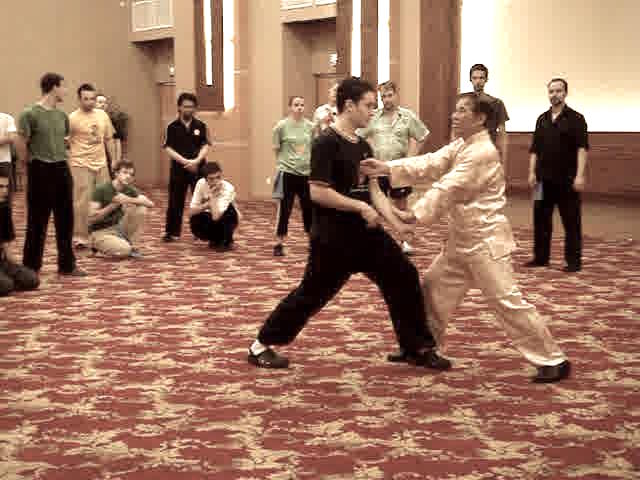
How would you implement your planned attacks on your opponent if you do not know what responses he will make? There are certain secrets which enable you to do so. Grandmaster Wong generously explains these secrets at the course.
Click here to enter.
Against Boxing, Kick-Boxing and Taekwondo
Covering the Fast Strikes of a Boxer
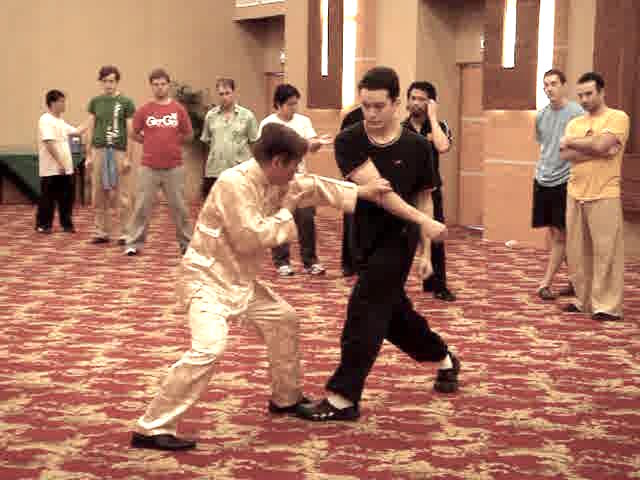
If you can handle cover a Boxers fast strikes, you can beat him quite easily as he does not have many techniques. If you fail to do this, you are in for trouble.
Click here to enter.
Avoiding a Boxer's Strong Points and Attacking his Weakness
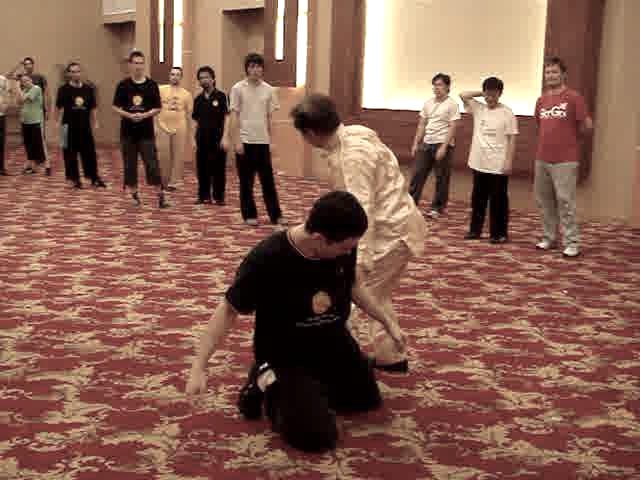
Avoid an opponents strong points and attack his weakness. This is an excellent tenet in combat. Covering a Boxer will avoid his strong points, felling him is attacking his weakness.
Click here to enter.
Counters against Hooks and Undercuts
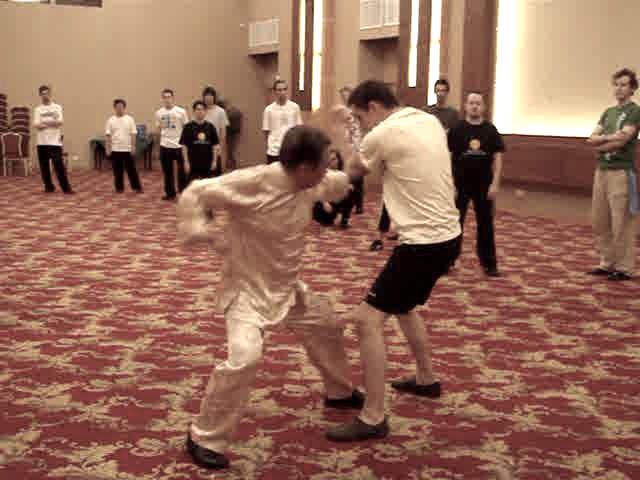
Intercepting with Por Pai Sau or Flank-Breaking Hnad is an effective counter against hooks. An effective counter against undercuts is to follow their momentum, grip the opponents arm, then fell him or strike his ribs.
Click here to enter.
Handling Aggressive Attackers and Counters against Chain Punches
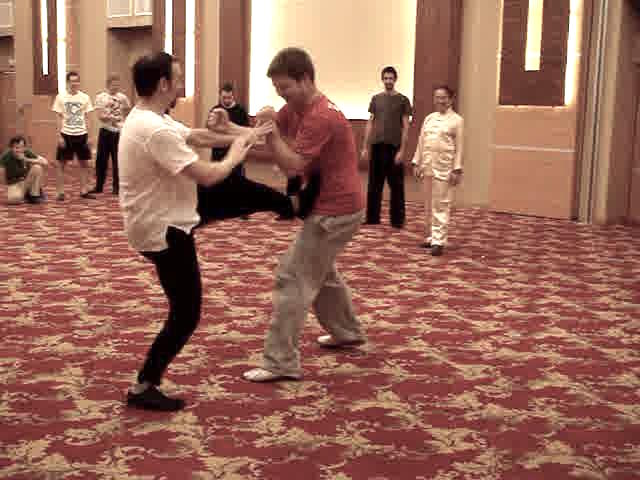
Course participants provide some excellent counters against aggressors who fight like Boxers as well as against chain punches.
Click here to enter.
Attacking the Weaknesses of Kick-Boxers
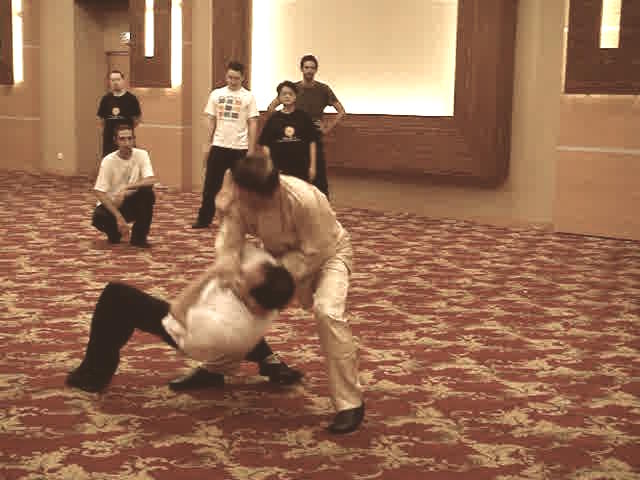
If you can handle kicks efficiently, defeating a Kick-Boxer is easier than defeating a Boxer because of the kicks. This video series show some effective tactics against Kick-Boxers.
Click here to enter.
Moving to the Back of an Opponent who Kicks
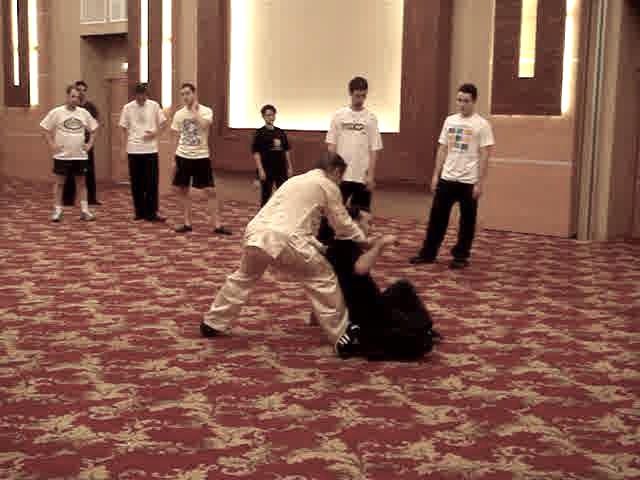
Grandmaster Wong shares some of his tactics against Taekwondo kicks, including moving to the back of the attackers.
Click here to enter.
Effective Counters against Taekwondo Kicks
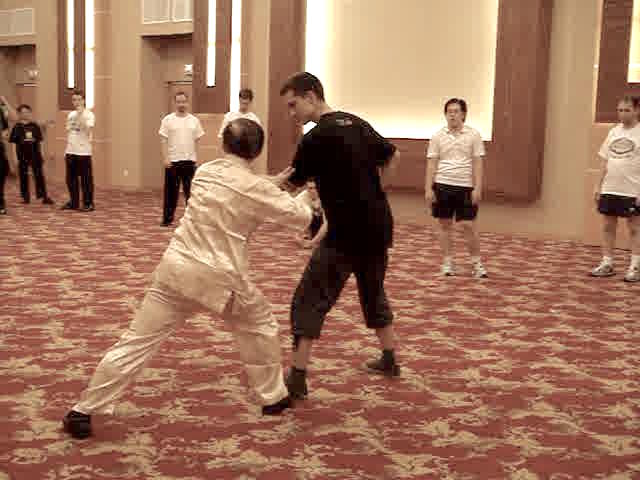
Grandmaster Wong explains some finer points in moving to the back of an opponent and felling him as he kicks. Another effective tactic is to strike his kicking leg, then strike him as he withdraws his leg. A third tactic is to fell him onto the ground.
Click here to enter.
Against Muay Thai and Wrestling
Counters against Muay Thai Attacks
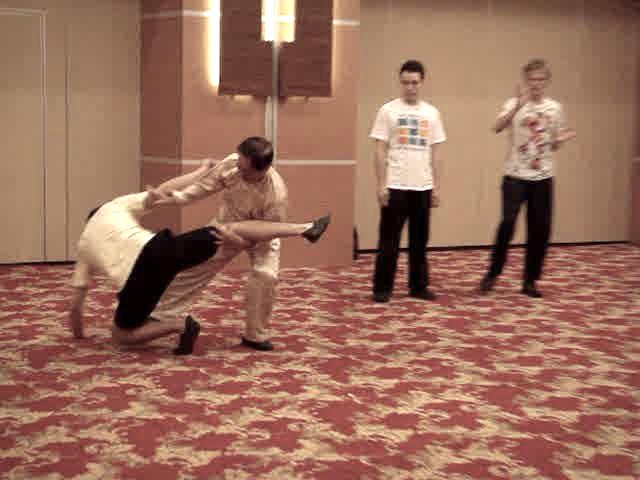
A Muay Thai fighter never attacks with individual techniques; he always attacks in a sequence. We can choose to counter at any point of his attacks.
Click here to enter.
When Leg Comes, Counter with Leg
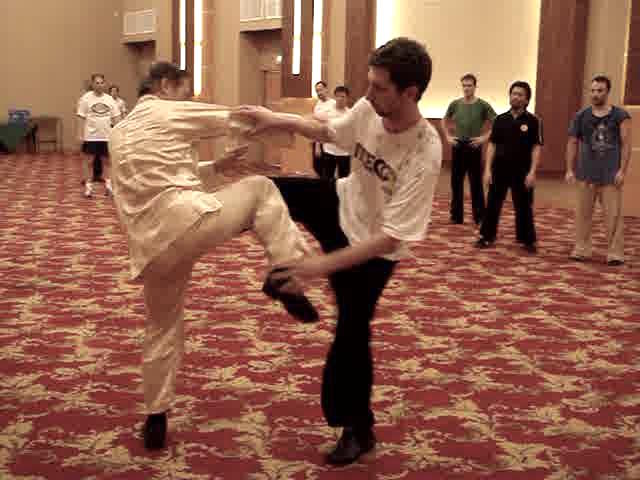
This is the Wing Choon principle of "kheok lei kheok ha siew", or "when leg comes, counter with leg". Grandmaster Wong also shows how you may move to an opponent's back how to make the first move.
Click here to enter.
Shoots, Lifts and Pin-Downs
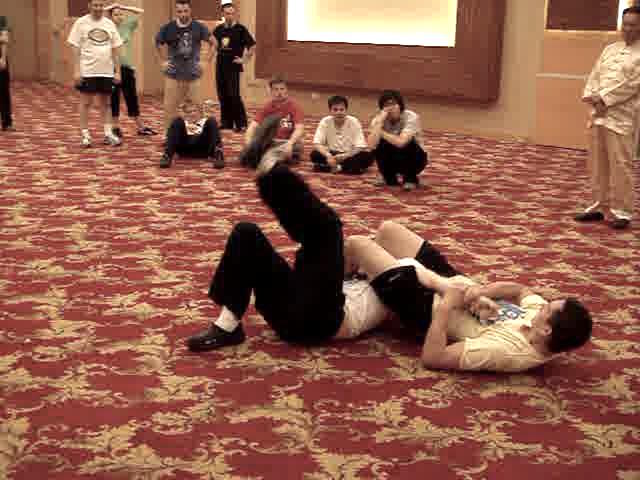
Sifu Robin demonstrates how to take down an opponent with a shoot or a lift, and pin him on the ground using the patterns "Frog Crouching on Ground" and "Lazy Man Smokes Pipe".
Click here to enter.
Lazy Man Smokes Pipe
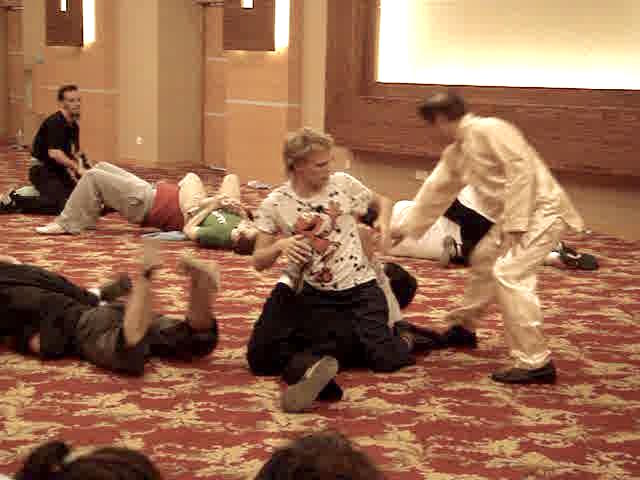
What would you do if an opponent pins you on the ground using the pattern "Frog Crouching on Ground", or threatening to break your arm with "Lazy Man Smokes Pipe"?
Click here to enter.
Having Fun with Wrestling Attacks and Counters
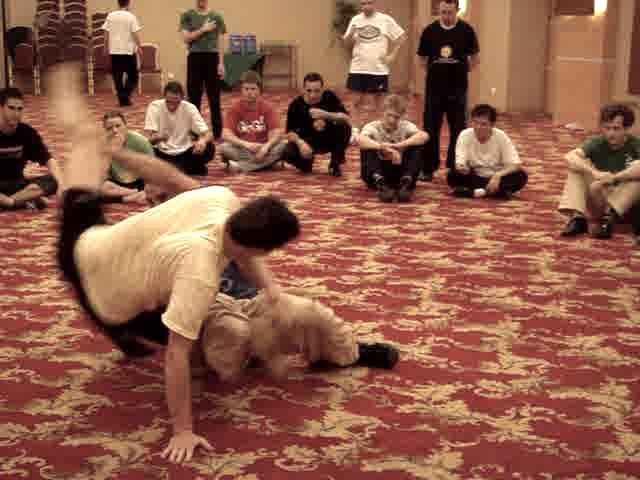
Sifu Robin and Sifu Eugene review the wrestling attacks and their counters. Course participants have a lot of fun practicing these techniques, followed by an interesting chi flow.
Click here to enter.
How did Past Wing Choon Masters Deal with Wrestlers and Grapplers?
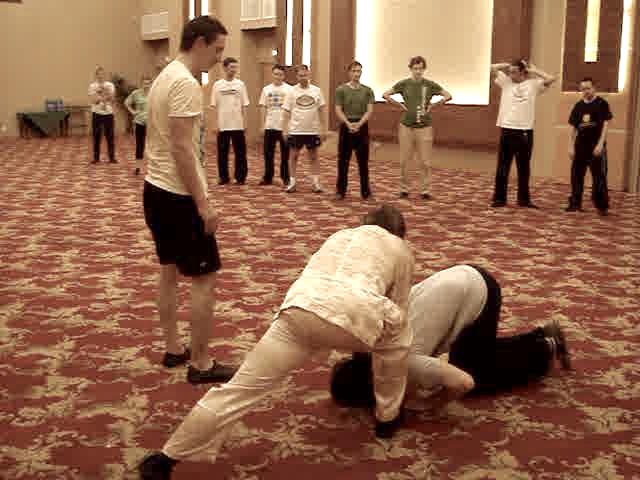
If an opponent were so foolish as to dangerously expose himself to attempt a shoot or a take-down, he would be killed or maimed. On the other hand, if the opponent were so fast or powerful that he could take a Wing Choon master down, he would be faster tearing out the master’s genitals.
Click here to enter.
Grand Finale and Post-Scripe
Free Movement Chi Sau while being Blind-Folded
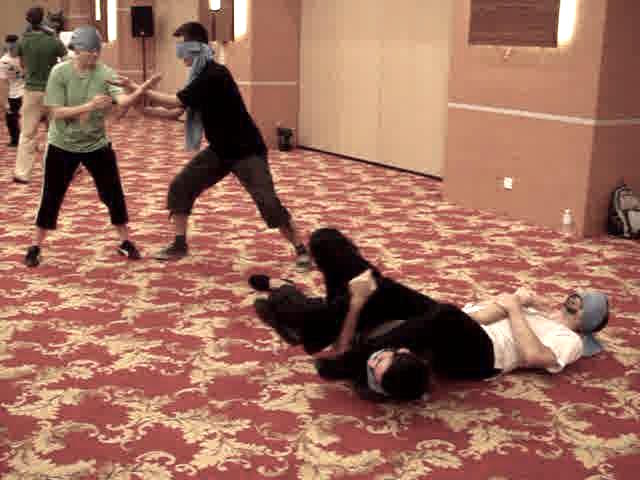
They practice free movement "chi sau" while being blind-folded. These skills will be very useful in combat as well as in daily life.
Click here to enter.
Wing Choon Kungfu Sets
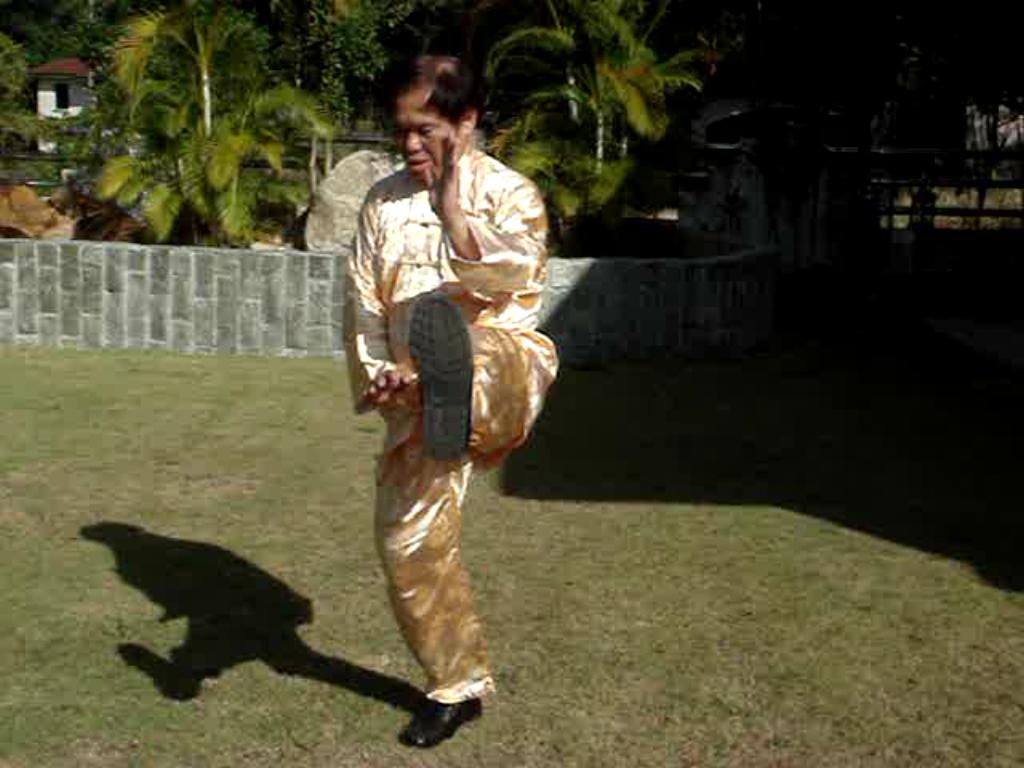
The various Wing Choon kungfu sets are placed here for easy reference. They include fundamental sets and chi sau sets.
Click here to enter.
- Developing Internal Force using Siu Lin Tou
- Learning the Forms of Siu Lin Tou
- Cham Kiew or Searching for Bridge
- Phew Chee or Thrusting Fingers
- Reviewing Basic Stances
- The Form-Level of Siu Lin Tou
- Using Energy Flow to Move Form
- Energy-Flow Level of Siu Lin Tou
- Converting Energy Flow to Internal Force
- Internal Force Level of Siu Lin Tou
- Hard and Soft Internal Force
- Introduction to Chi Sau
- The Importance of Waist Rotation
- Phong Sau and Kham Sau against Middle Attacks
- Low Attacks and their Defences
- Chiek Sau or Cutting Hand for Side Attacks
- The Form Level of Cham Kiew
- Using Energy to Direct Form, and Converting Energy to Internal Force
- Sequence of Attacks and Counters
- Applying Wing Choon Patterns for Combat
- Basic Hand Techniques of Stationary Chi Sau
- Developing Thien Keng or Sensing Skills
- Training of Energy and Mind
- The Use of Tactics
- Sensing with the Mind
- Sap Luk Sau or Sixteen Hand Techniques
- Performing Sap Luk Sau Blind-Folded
- Free Movement Chi Sau in Blind-Fold
- Taming or Locking an Opponent and Simultaneouly Striking Him
- Excellent Counters Proposed by Course Participants
- Exploiting Opponents' Weaknesses in Combat
- When you are being Locked and Pressed against a Wall
- Moving from In-Gate to Out-Gate
- Effective Counters against Grips and Locks
- No Defence Direct Counters against Formidable Bottom Attacks
- Horizontal Chops and Crane Beaks in Side Attacks
- Top and Middle Attacks and their Counters
- Bottom and Side Attacks and their Counters
- Learning the Forms of Phew Chee
- From Pattern Practice to Free Sparring
- Thrust Kicks and their Counters
- Smart Practice Makes Perfect
- Understanding Wing Choon Principles and Practice
- Practicing Chi Sau while being Blind-Folded
- Effective Counters against Kicks
- Cockerel Kicks against Whirlwind Kicks
- Counters against Low Sweeping Kicks
- Striking or Intercepting Opponents' Kicks
- Sap Ye Theak or Twelve Kicks
- How do you Escape this Difficult Situation
- Felling a Giant Almost Effortlessly
- Turning a Weakness into a Strength
- Butterfly Palms against Double-Grip Chin-Na Attack
- Do you Know the Combat Applications of these Apparently Useless Patterns?
- Sophisticated Applications of Seemingly Harmless Patterns
- Have Fun Dicephering Sophisticated Applications from Innocent-Looking Paterns
- Big and Small Movements in Wing Choon Hand Techniques
- The Course is Full of Interesting Surprises
- Felling Techniques in Wing Choon Kungfu
- Neutralizing Opponents' Attacks with your Legs!
- Chin-Na Attacks and their Counters
- Theit-Cheit-Na or Fell-Knee-Grip
- How Elegant Ladies Can Handle Muscular Brutes
- Free Sparring while being Blind-Folded
- Deflecting Attacks Without Looking at Them
- Moving from Technique-Level to Sequence-Level in Sparring
- Small Difference in Movements Can Make Big Difference in Results
- Applying Planned Sequence Irrespective of Opponents Response
- Don't Hand your Defeat to your Opponent
- Marvelous Techniques Beget Marvelous Techniques
- Creating Opportunity to Defeat Opponent
- Secrets of Crane Beak and Double Punch
- Open Secrets and Close Secrets
- Secrets of Sequence Sparring
- Covering the Fast Strikes of a Boxer
- Avoiding a Boxer's Strong Points and Attacking his Weakness
- Counters against Hooks and Undercuts
- Handling Aggressive Attackers and Counters against Chain Punches
- Attacking the Weaknesses of Kick-Boxers
- Moving to the Back of an Opponent who Kicks
- Effective Counters against Taekwondo Kicks
- Counters against Muay Thai Attacks
- When Leg Comes, Counter with Leg
- Shoots, Lifts and Pin-Downs
- Lazy Man Smokes Pipe
- Having Fun with Wrestling Attacks and Counters
- How did Past Wing Choon Masters Deal with Wrestlers and Grapplers?
- Free Movement Chi Sau while being Blind-Folded
- Wing Choon Kungfu Sets
LINKS
